77 Florida Native Plants: Flowers, Trees, and Shrubs – Identification Guide (with Pictures)

Do you want to incorporate native plants into your Florida garden? Native plants in Florida are well-suited for planting across the Sunshine State. From flowers and shrubs to vining plants and trees, these native species thrive in the hot and humid conditions that define this southeastern region.
This guide to native plants in Florida will help you discover low-maintenance ground cover plants, flowering tropical shrubs, and large shade-providing trees that thrive in Florida’s abundant sunshine.
Florida native plants are defined as plant species that naturally occur and have developed in the state of Florida without human intervention. These plants have adapted to Florida’s specific climate, soil, and environmental conditions over time.
Growing Florida native plants offers numerous benefits to both the environment and gardeners themselves. Native plants are well-adapted to the local climate, making them low-maintenance and drought-tolerant once established. They require less water, fertilizer, and pesticides, reducing the overall environmental impact of gardening. Native plants provide essential food and habitat for local wildlife, such as pollinators and birds, supporting biodiversity and fostering a healthy ecosystem.
Whether you reside south of Lake Okeechobee, in central Florida between Orlando and Tampa, or in northern Florida spanning from Jacksonville to the Panhandle, these native plants offer excellent landscaping solutions.
Native Florida Flowers (with Pictures) – Identification Guide
Native Florida flowers are a great way to add color, texture, and floral aromas to your garden. The good news is that there are plenty of native flowers that thrive in Florida’s subtropical and tropical climate.
Beach Sunflower (Helianthus debilis)

Native to coastal areas of Florida, the beach sunflower is a fast-growing perennial with yellow sunflower-like blooms and triangular leaves. This sun-loving plant blooms from spring through fall and is perfect for beach or coastal locations throughout Florida. The sprawling flowering plant also cascades over walls or is useful for edgings.
Ideal for flowering ground cover in full sun, beach sunflower thrives in USDA zones 8 to 11.
Florida Native Plant Identification
Beach sunflower is a spreading perennial plant ideal for Florida’s coastal areas with yellow flowers 3” (7.5 cm) across and deltoid leaves measuring 4” (10 cm). The ground-hugging perennial grows 1 to 2 ft. (0.3 – 0.6 m) tall and 4 ft. (1.2 m) wide.
- USDA Growing Zone: 8 to 11
- Sun Exposure: Full sun
- Soil Needs: Well-drained soil
- Water Needs: Moderate
- Mature Size: 1 to 2 ft. tall and 4 ft. wide
Black-Eyed Susan (Rudbeckia hirta)
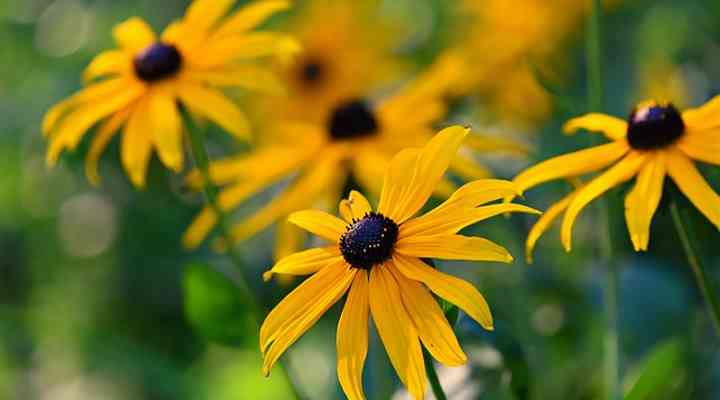
The black-eyed Susan is a native wildflower of Florida, perfect for gardens and natural areas. This perennial is easily identified by its daisy-like yellow flowers growing on tall upright stems. The bright yellow petals surround a dark brown central disk. Its rough, hairy, lanceolate leaves grow on tall, upright stems measuring 3 ft. (1 m) high.
Black-eyed Susan flowers bloom throughout summer until fall from North Florida and south to Miami. They thrive in sunny outdoor spots in USDA zones 2 through 10.
Florida Native Plant Identification
Black-eyed Susan flowers are bright golden yellow, measuring 3” (7.5 cm) wide. The sparse linear leaves grow 3” to 7” (7 – 17 cm) long.
- USDA Growing Zone: 2 through 10
- Sun Exposure: Full sun
- Soil Needs: Well-drained soil
- Water Needs: Moderate
- Mature Size: Up to 3 ft. tall
Carolina Jessamine (Gelsemium sempervirens)
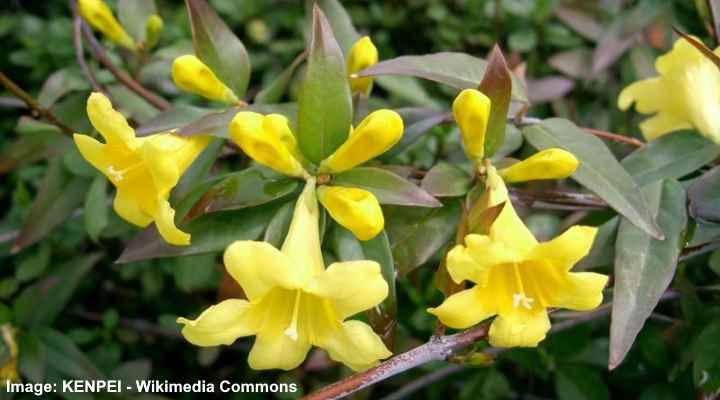
Carolina jessamine is a flowering vine native to the southeastern United States. It is known for its masses of fragrant yellow trumpet-shaped flowers. Ideal for all regions of Florida, this twining evergreen climber blooms from late winter until spring and again in the fall. This showy yellow-flowering vine is perfect for covering trellises, arbors, pergolas, and chain-link fences.
Carolina jessamine flowers grow in full sun in USDA zones 7 to 10. You can prune it to grow as a flowering shrub, let it scramble over garden structures, walls, or fences, or grow as yellow-flowering ground cover in full sun.
Florida Native Plant Identification
Identifying features of native Carolina jessamine are its clusters of funnel-like butter-yellow blooms measuring 1.5” (3 cm) across and its pointed, glossy green leaves 1” to 3” (2.5 – 7.5 cm) long. The climbing vine grows 10 to 20 ft. (3 – 6 m) tall and 6 ft. (1.8 m) wide.
- USDA Growing Zone: 7 to 10
- Sun Exposure: Full sun
- Soil Needs: Well-drained soil
- Water Needs: Moderate
- Mature Size: 10 to 20 ft. tall and 6 ft. wide
Climbing Aster (Symphyotrichum carolinianum)
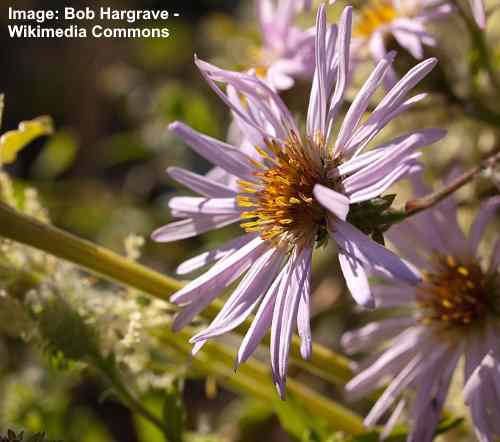
The showy climbing aster is a native vining plant in Florida that grows in full sun. The sprawling vine thrives in wet areas where its showy lavender, purple, or pink flowers decorate the banks of lakes, ponds, and streams. Climbing aster with its daisy-like flowers also attracts pollinators, bees, and other native Florida wildlife.
This purple-flowering climbing plant performs best in USDA zones 8 through 10. It is intolerant to salty wind or sea spray, so the flowers must grow well away from coastal areas in Florida.
Florida Native Plant Identification
Climbing asters grow 12 ft. (3.6 m) tall and 2 to 4 ft. (0.6 – 1.2 m) wide. The pinkish-purple ray flowers have slender petals forming a disk shape. Its small gray-green ovate leaves grow densely on the spreading stems.
- USDA Growing Zone: 8 through 10
- Sun Exposure: Full sun
- Soil Needs: Well-drained soil
- Water Needs: Moderate
- Mature Size: 12 ft. tall and 2 to 4 ft. wide
Crossvine (Bignonia capreolata)
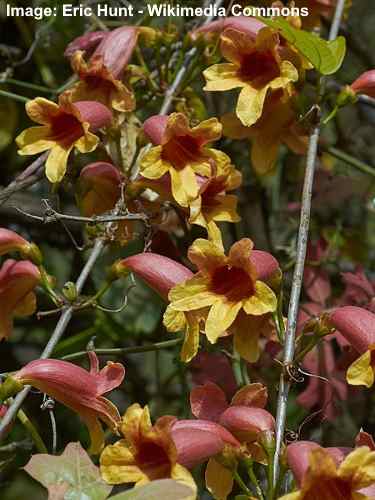
Crossvine is a spectacular native Florida flower ideal for landscaping gardens in North and Central Florida. The vigorous woody vine produces vibrant clusters of trumpet-shaped blooms in shades of orange, yellow, and red. Its large leaves, colorful blossoms, and self-clinging habit make crossvine ideal for covering fences, arbors, pergolas, or unsightly garden structures.
Growing easily in the sun or partial shade, crossvine can be an ideal way to brighten up a backyard in USDA zones 6 through 9. In colder areas, the dense foliage turns reddish-purple in the fall before falling. In Central Florida, the vining plant is evergreen.
Florida Native Plant Identification
Crossvine is identified by its large orange-red clusters of trumpet-shaped flowers with up to five flowers per cluster, each measuring 2” (5 cm) long. The tendril stems grow quickly 30 to 50 ft. (9 – 15 m) long and 9 ft. (2.7 m) wide.
- USDA Growing Zone: 6 through 9
- Sun Exposure: Full sun to partial shade
- Soil Needs: Well-drained soil
- Water Needs: Moderate
- Mature Size: 30 to 50 ft. long and 9 ft. wide
Trumpet Creeper (Campsis radicans)
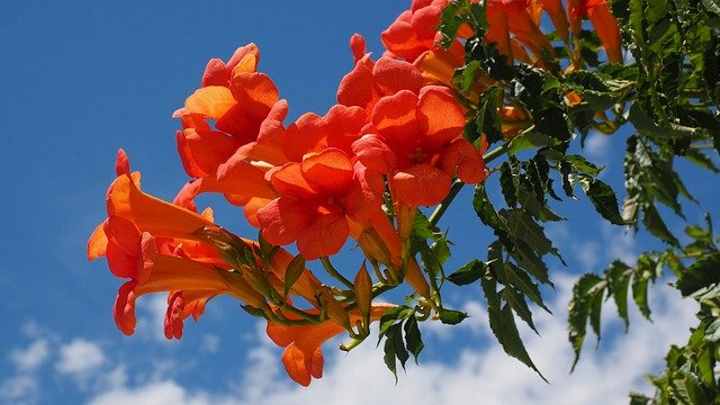
The trumpet creeper is a beautiful native flowering vine for Florida gardens that adds a vibrant splash of orange and red colors to a southern landscape. Ideal for regions north of Lake Okeechobee, this long-blooming orange-flowering vine quickly covers walls, fences, trellises or spreads over bare ground. In addition, its attractive flowers, foliage, and showy bean pods give the vine huge ornamental value.
Trumpet creeper vines are easy to grow, drought tolerant, heat, and cold-resistant. The self-cling woody climber thrives in USDA zones 5 through 9, making it an ideal native Florida flower for the northern and central regions of Florida.
Florida Native Plant Identification
The trumpet creeper vine is identified by its bright orange-red trumpet-shaped flowers measuring 3” (7.5 cm) long. It also has pinnately compound leaves with seven to 11 leaflets measuring 4” (10 cm) long. The vine grows 20 to 40 ft. (6 – 9 m) tall.
- USDA Growing Zone: 5 through 9
- Sun Exposure: Full sun
- Soil Needs: Well-drained soil
- Water Needs: Moderate
- Mature Size: 20 to 40 ft. tall
Scarlet Salvia (Salvia coccinea)
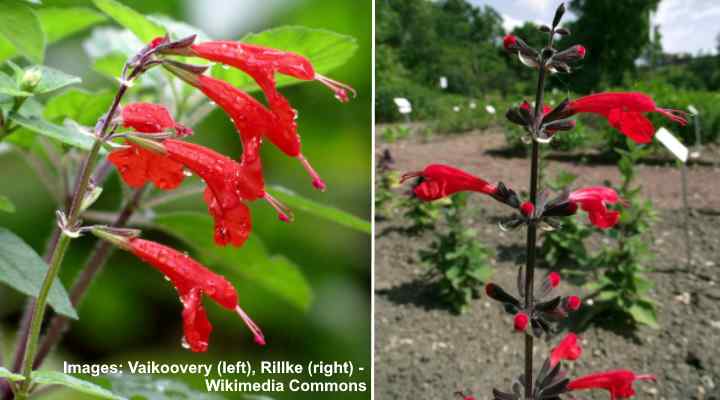
Also called tropical sage, scarlet salvia is a stunning native flower that grows in Florida landscapes from the Panhandle to the Keys. This attractive vibrant crimson-flowering tender perennial has dark-green heart-shaped leaves, making these low-maintenance flowers ideal for beds and borders in subtropical landscapes.
Scarlet salvia is tolerant of drought and thrives in full sun and sandy soil. Perfect for USDA zones 8 to 11, you should give the perennial some afternoon shade in South Florida. Its long blooming period extends from June through October.
Florida Native Plant Identification
Identification features of scarlet sage are its bright red two-lipped tubular flowers growing on flowering spikes 12” (30 cm) tall. In addition, the plant has pea-green, hairy leaves with scalloped margins.
- USDA Growing Zone: 8 to 11
- Sun Exposure: Full sun
- Soil Needs: Well-drained soil
- Water Needs: Moderate
- Mature Size: 12 in. tall
Purple Coneflower (Echinacea purpurea)

Purple coneflower is a sun-loving herbaceous perennial with rose-purple daisy-like flowers featuring drooping rays surrounding a spiny cone-like center. These showy blossoms grow at the top of clumping, erect stems that can form a spectacular border or back-of-the-bed planting. The attractive, hardy flowers attract butterflies and other pollinators, making them great for wildlife gardens.
Purple coneflowers grow 3 to 4 ft. (1 – 1.2 m) tall in clumps 2 ft. (0.6 m) wide. Tolerating drought, humidity, and heat, these native flowers are suitable for growing in Central and Northern Florida (USDA zones 4 to 9).
Florida Native Plant Identification
Native to Florida, purple coneflowers are identified by their radial purple, pink, or orange disk-shaped flowers containing seven to 20 linear petals. The large daisy-like blooms with a domed central disk and drooping rays measure 5” (13 cm) across.
The most common varieties are pink and purple flowers. But native echinacea plants also have white, yellow, red, and orange blooms.
- USDA Growing Zone: 4 to 9
- Sun Exposure: Full sun
- Soil Needs: Well-drained soil
- Water Needs: Moderate
- Mature Size: 3 to 4 ft. tall in clumps
Orchids Native to Florida
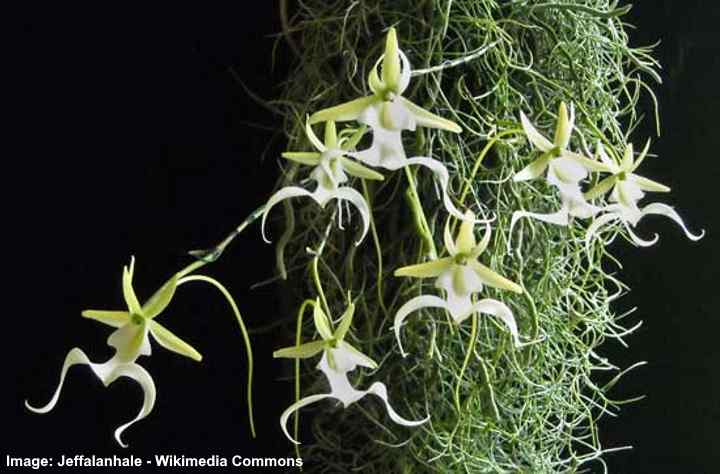
Ghost orchid
Over 100 orchid species are native to Florida, where they thrive in the hot and humid climate. These tropical flowers are some of the most colorful and exotic flowers to grow indoors or outdoors. Here are some details on Florida’s native orchid flowers:
Ghost Orchid (Dendrophylax lindenii): This rare type of orchid is only found in the wild in Collier and Hendry counties. The white-flowering tropical plant has large white petals with two long thin dangling petals.
Butterfly Orchid (Encyclia tampensis): This showy native orchid species has small flowers in green, orange, copper, and yellow colors. The plant’s name comes from the flowers looking like exotic butterflies. The cold hardy orchids grow from northern Florida and south to Miami and the Keys.
Spider Orchid (Brassia caudata): Native to southern Florida, the spider orchid has spindly flowers, slender greenish-yellow petals, and brown smudges.
- USDA Growing Zone: 10 to 11
- Sun Exposure: Shady, often in tree shade
- Soil Needs: Well-draining orchid mix
- Water Needs: High humidity, regular moisture
Indian Blanket (Gaillardia pulchella)
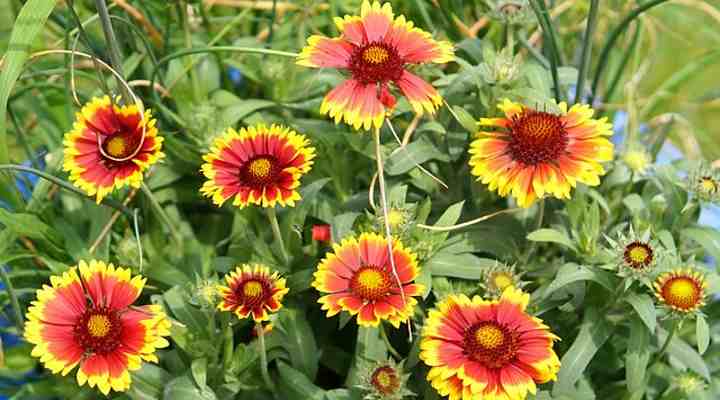
The Indian blanket is a tropical native flower that grows in the wilds of Florida. The vibrant, eye-catching daisy-like blooms have bright red petals with yellow tips. These long-blooming flowers provide bright color to gardens in the south from spring through fall. This short-lived perennial thrives in warm, coastal areas.
Vibrant red blooms with yellow accents grow on upright stems 1 to 2 ft. (0.3 – 0.6 m) tall. Suitable for all regions of Florida, the wildflower tolerates sun, heat, and humidity.
Florida Native Plant Identification
Indian blanket has red and yellow ray flowers with linear petals surrounding a large brownish-red center disk. The flowers measure 2” (5 cm) across, and the pointed lanceolate leaves are 3” (7.5 cm) long.
- USDA Growing Zone: Zones 8 to 11
- Sun Exposure: Full sun
- Soil Needs: Well-draining soil
- Water Needs: Moderate, drought-tolerant once established
- Mature Size: Upright stems 1 to 2 ft. (0.3 – 0.6 m) tall
Ohio Spiderwort (Tradescantia ohiensis)
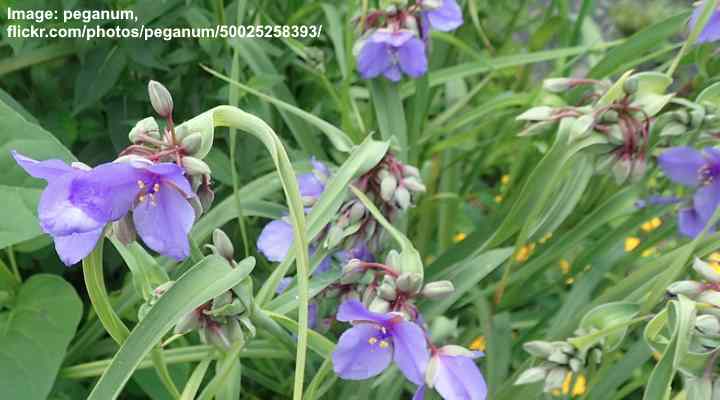
Ohio spiderwort is a beautiful native wildflower that is perfect for adding color to Florida gardens. The plant’s attractive features are its purple three-petaled flowers and clump-forming grass-like foliage. Although the flowers only bloom for a day, its prolific blooming means the plant has flowers for six weeks from late spring.
This herbaceous perennial thrives in Central and North Florida in USDA zones 4 to 9. The flowering plant is ideal for adding interest to any flowerbed or container garden in full sun or partial shade.
Florida Native Plant Identification
Ohio spiderwort is identified by its grass-like foliage and purple flowers. The plant’s long, narrow leaves are 6” (15 cm) long. The purple-blue flowers measure up to 3” (7.5 cm) across, with six showy yellow stamens in the center.
- USDA Growing Zone: Zones 4 to 9
- Sun Exposure: Full sun to partial shade
- Soil Needs: Well-draining soil
- Water Needs: Moderate
- Mature Size: Grass-like foliage with long, narrow leaves 6” (15 cm) long
Swamp Sunflower (Helianthus angustifolius)
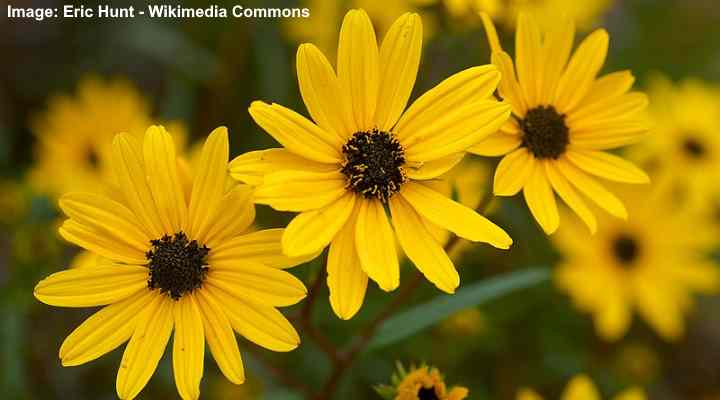
The swamp sunflower is a stunning, native wildflower with vibrantly-colored yellow flowers that brighten any Florida garden landscape. Each daisy-like flower head has 10 to 20 golden yellow petals surrounding a dark brown center. Its long-lasting blooms make it ideal for seasonal beds, borders, or pathways.
Swamp sunflower grows best in full sun and tolerates wet soils and salty air. The flowering stems, covered with narrow, willow-like leaves, grow 5 to 8 ft. (1.5 – 2.4 m) tall and up to 4 ft. (1.2 m wide). Blooming late in the season, swamp sunflower is ideal for adding a pop of color to fall gardens in the Southeast United States.
Florida Native Plant Identification
Identification features of swamp sunflower plants are their masses of bright yellow ray flowers measuring 2” to 3” (5 – 7.5 cm), tall, sturdy stems, and slender leaves measuring 6” (15 cm) long.
- USDA Growing Zone: Zones 8 to 10
- Sun Exposure: Full sun
- Soil Needs: Well-draining soil
- Water Needs: Moderate
- Mature Size: 5 to 8 ft. (1.5 – 2.4 m) tall
Coral Honeysuckle (Lonicera sempervirens)

Coral Honeysuckle is a native Florida twining climber with clusters of slender red tubular flowers. The vining plant blooms in early spring, and the flowers persist through summer. These showy flowers give way to bright red summer berries. This honeysuckle variety is described as one of the showiest vining plants for Florida gardens.
Coral honeysuckle is a fast-growing evergreen climber for gardens in Florida north of Fort Myers and Lake Okeechobee to Jacksonville. The twining stems grow 8 to 15 ft. (2.4 – 4.5 m) tall and up to 6 ft. (1.8 m) wide. The red-flowering vine is a great choice to add a splash of color and interest to your landscape while attracting hummingbirds and butterflies. It grows in full sun or partial shade.
Florida Native Plant Identification
Coral honeysuckle’s identifying characteristics include its clusters of 2” (5 cm) red tubular flowers, bright red berries, and evergreen foliage. The twining stems are covered in small oblong blue-green leaves that stay green in warm winter climates.
- USDA Growing Zone: Zones 8 to 10
- Sun Exposure: Full sun to partial shade
- Soil Needs: Well-draining soil
- Water Needs: Moderate
- Mature Size: 8 to 15 ft. (2.4 – 4.5 m) tall and up to 6 ft. (1.8 m) wide
Wild Columbine (Aquilegia canadensis)
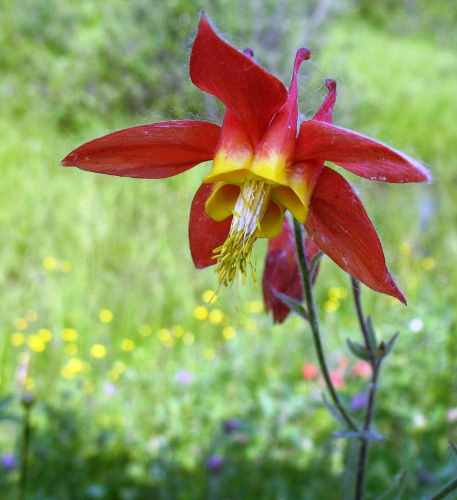
Wild columbine is an eye-catching tubular wildflower native to the panhandle of northern Florida. The dainty papery flowers combine red and yellow petals, nodding on arching, thin, wiry stems. Additionally, attractive foliage consists of fern-like three-lobed leaves. It is also attractive, with blue-green leaves that are divided into lobes.
Wild columbine thrives in full sun in USDA zones 3 to 8. Its red and yellow flowers are ideal for adding color to rock gardens, naturalized areas, or underplanting shrubs. The short-lived, self-seeding flowers grow in bushy mounds 24” to 36” (60 – 90 cm) tall and up to 18” (45) wide. The flowers bloom in late spring to early summer, attracting hummingbirds and butterflies to the garden.
- USDA Growing Zone: 3 to 8
- Sun Exposure: Full sun or partial shade
- Soil Needs: Organically rich, moist soils
- Water Needs: Well-drained soils with medium moisture
Leavenworth’s Tickseed (Coreopsis leavenworthii)

Tickseed is a native Florida annual flower with stunning yellow daisy-like flowers. The flower’s eye-catching feature is the distinct mahogany brown button center surrounded by bright yellow petals. This yellow wildflower has erect slender stems and grass-like foliage growing up to 4” (10 cm) tall and thrives throughout the Sunshine State.
Yellow tickseed flowers are perfect for brightening sunny front and backyards. The long-lasting blooms attract butterflies and bees to the gardens in the southeastern US. The versatile flowers perform well in borders, containers, mass plantings, and rock gardens. The low-maintenance flowers tolerate drought conditions, making them excellent for Florida’s hot and sunny climate.
Tickseed plants are suitable for growing in USDA zones 4 to 9, depending on the variety.
- USDA Growing Zone: 8 to 11
- Sun Exposure: Full sun
- Soil Needs: Slightly alkaline, sandy to clay soils
- Water Needs: Consistently moist, occasionally wet
Dusty miller (Senecio cineraria)

Dusty miller is a group of sun-loving plants identified by their silvery-gray fuzzy fern-like foliage and yellow flower clusters. Growing less than a foot (30 cm) tall, the velvety silvery-white lobed leaves contrast beautifully with other garden plants. This low-growing perennial subshrub thrives throughout Florida—from the panhandle to the Florida Keys.
Dusty miller plants are heat and drought-tolerant, thriving in full sun or part shade. The finely textured silver leaves add color and texture to borders, ground cover, coastal gardens, and container gardens. Dusty miller is suitable for growing in USDA zones 8 through 11.
- USDA Growing Zone: 8 to 11
- Sun Exposure: Full sun or partial shade
- Soil Needs: Average soil
- Water Needs: Well-drained soils and the plant is drought-tolerant
Burr Marigold (Bidens laevis)

Burr marigold is a yellow-flowering plant native to all regions of Florida. The bright yellow flowers have eight oval petals surrounding a dark yellow cone-like center. Also known as smooth beggarticks or swamp marigold, the sun-loving perennial has upright growth with narrow lanceolate leaves 6” (15 cm) long.
Burr marigold is a low-maintenance flowering plant that blooms from early summer to mid-fall. It thrives in soggy soil, making it a good addition to bog gardens and native plant gardens or planting near ponds. Burr marigold is also ideal for planting in gardens with poor drainage.
You can plant burr marigolds in full sun or partial shade in USDA zones 8 to 10.
- USDA Growing Zone: 8 to 10
- Sun Exposure: Full sun or partial shade
- Soil Needs: Sandy, loamy, or clay soils
- Water Needs: Consistently moist soils
Sunflowers (Helianthus annuus)
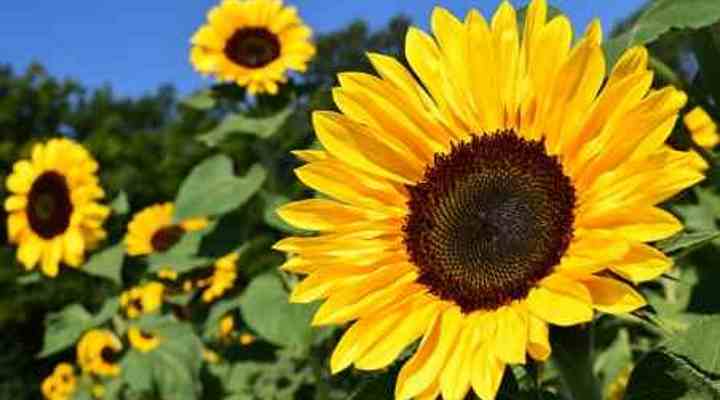
Native sunflowers are iconic sun-loving plants known for their tall stems and huge, vibrant yellow ray flowers. These annual yellow flowers can grow 5 ft. (1.5 m) tall and bloom in mid-spring in Florida before fading in the Sunshine State’s hot, humid summers. You can also plant sunflowers in early fall to enjoy stunning fall flowers.
Common sunflowers produce yellow blooms 6” to 12” (15 – 30 cm) across. Due to their tall stature, the yellow flowers are a terrific addition to back-of-border planting or growing along a fence line. The nectar-rich flowers also attract pollinators, making them great for wildlife gardens.
Sunflowers are also tolerant to various soil types and withstand salt spray, making them ideal for planting in Florida’s coastal regions. Sunflowers are suitable for growing in USDA zones 2 through 11
- USDA Growing Zone: 2 to 11
- Sun Exposure: Full sun
- Soil Needs: Humus-rich, moderately fertile soil, also tolerates poor soil
- Water Needs: Well-drained soil
Swamp Sunflower (Helianthus angustifolius)

Swamp sunflower is one of the most attractive native yellow flowers in Florida. The sun-loving mounding plant has yellow petals in rays surrounding a dark brown center. Swamp sunflowers bloom in late summer and fall. An identifying feature is the plant’s narrow, willow-like leaves.
Swamp sunflowers are ideal for planting in wet or boggy areas, such as along the edges of ponds or in rain gardens. Thriving in full sun, the vibrant yellow flowers look spectacular in wildflower gardens, coastal gardens, and containers. The yellow-flowering plants have a clumping growth habit and can spread over time.
- USDA Growing Zone: 5 to 10
- Sun Exposure: Full sun to partial shade
- Soil Needs: Acidic to neutral soils
- Water Needs: Well-drained soils that are consistently moist
Spiked Blazing Star (Liatris spicata)
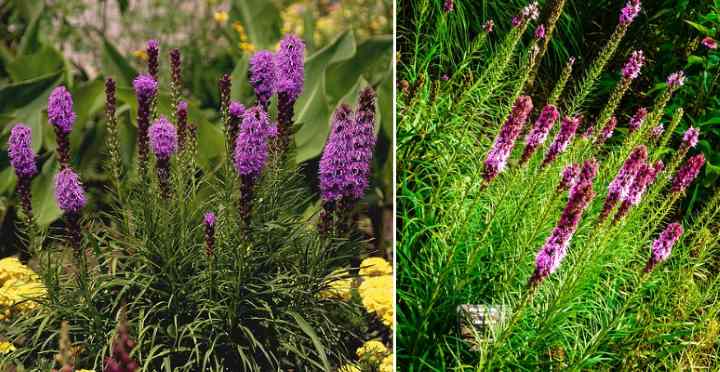
Spiked blazing star is a tall, sun-loving perennial that produces vibrant purple flower spikes. Native to Florida, the eye-catching purple flowers form densely packed clusters growing stalks up to 4 ft. (1.2 m) tall. The ornamental flowers have narrow, arching leaves growing up the flower spikes, which bloom from summer through fall.
Spiked blazing stars attract pollinators like bees, butterflies, and hummingbirds to gardens. Thriving in full sun throughout Florida, the purple or pink flowers brighten perennial borders, native plant gardens, and borders. The plant is also deer-resistant and drought-tolerant, making it a low-maintenance option for sunny landscapes.
This perennial is best suited for USDA zones 3 to 10 and thrives in well-drained soil.
- USDA Growing Zone: 3 to 10
- Sun Exposure: Full sun
- Soil Needs: Moderately fertile soils, tolerates poor, dry soils
- Water Needs: Moist, well-drained soils
Swamp Lily (Crinum americanum)

Swamp lily is a white-flowering plant with spidery white flowers and strap-like leaves. Native to the southeastern US, the unique flowers have narrow, six curled white petals 4” (10 cm) with long, showy purple stamens. The clumping plant grows up to 3 ft. (1 m) tall.
Swamp lily blooms throughout summer to the fall and thrives in moist to wet organically rich soil in full sun. White swamp lily flowers are perfect for adding a touch of elegance to water gardens or areas in your yard with poor drainage. They thrive in all areas of Florida in USDA zones 8 through 10.
- USDA Growing Zone: 8 to 10
- Sun Exposure: Full sun to partial shade
- Soil Needs: Organically rich soils
- Water Needs: Moist to wet soils, it’s not drought-tolerant
Florida Violets (Viola spp.)
Florida violets are small, delicate purple, yellow, or white flowers that thrive in sunny areas throughout Florida. These low-growing native plants typically grow in shaded, damp areas of the Sunshine State. They usually bloom in late winter and spread easily. Wild violets usually grow less than a foot (30 cm) tall.
Here are some identifying features of violets native to Florida:
Common blue violet (Viola sororia): This dainty purple-flowering native plant has blue-violet flowers with prominent white throats. It also has heart-shaped leaves and grows 6” to 10” (15 – 25 cm) tall.
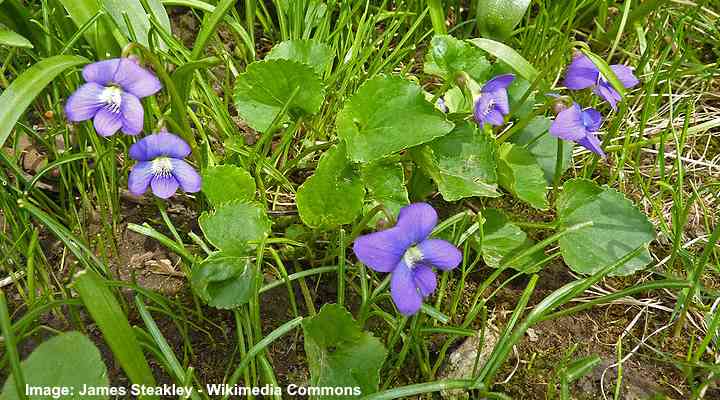
Common Blue Violet (Viola sororia)
Walter’s violet (Viola walteri): This mat-forming purple-flowering plant is identified by its blue-purple flowers and rounded leaves. It’s one of the few violets native to Florida that has trailing stems. It grows 1” to 6” (2.5 – 15 cm) tall. Found in North Florida in woodlands.
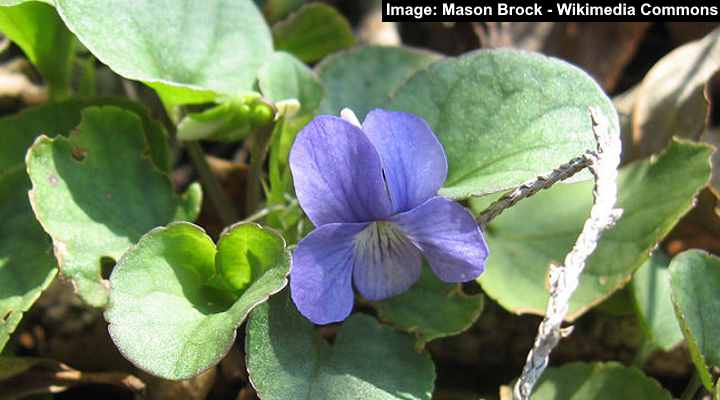
Walter’s violet (Viola walteri)
Bog white violet (Viola lanceolata): This attractive native-to-Florida violet is distinguished by its five-petalled white flowers, lanceolate leaves, and early spring blooming time. The violet’s erect stems grow up to 6” (15 cm) tall. It is found throughout the state, growing near ponds and streams.

Bog white violet (Viola lanceolata)
Sand violet (Viola affinis): Native to Florida, the sand violet is recognized by its pale purple and white petals, coarsely-toothed heart-shaped leaves, and tolerance for shade and moist soils. This variety grows 6” to 10” (15 – 25 cm) tall and up to 8” (20 cm) wide.

Florida violets are ideal for growing in Central and North Florida shade gardens. They thrive in the ground throughout the year but may go dormant in the summer heat. Depending on the variety, you can grow violets in Florida as ground cover for shade, bedding plants, or garden edging.
- USDA Growing Zone: 3 to 10
- Sun Exposure: Light shade to partial shade
- Soil Needs: Humus-rich, moisture-retentive soil
- Water Needs: Medium moisture
Butterfly Weed (Asclepias tuberosa)

Butterfly weed is an easy-care, sun-loving perennial plant known for its clusters of bright orange flowers. Blooming in full sun throughout summer in Florida, the clumping plant has lance-shaped leaves and umbrella-like, flat-topped flower clusters. Not growing more than 2 feet (0.6 m), the bushy perennial attracts monarch butterflies.
Butterfly weed is ideal for North and Central Florida’s climate. The star-shaped orange flowers contrast nicely with the green leaves before giving way to attractive seed pods. The low-maintenance plant tolerates drought, heat, and full sun. It’s suitable for planting in borders, wildflower gardens, butterfly gardens, and along a foundation line.
Butterfly weed is native to Florida and grows in USDA zones 3 to 9.
- USDA Growing Zone: 3 to 9
- Sun Exposure: Full sun
- Soil Needs: Poor, dry soils
- Water Needs: Medium moisture, well-drained
Elliott’s Aster (Symphyotrichum elliottii)

Elliott’s aster is a beautiful purple-flowering plant native to all regions of Florida except the panhandle. This eye-catching feature of this native aster is its clusters of small, daisy-like flowers in shades of purple, blue, and pink. The disk florets bloom in late summer and fall, contrasting nicely with the dark green lanceolate leaves.
Elliott’s aster is a versatile landscaping flower with several uses in southeastern garden settings. The bushy flowering plant is suitable for borders, wildflower gardens, and planting along a fence line. It thrives in sandy, loamy soils in full sun. Elliott’s aster is a stunning addition to southern gardens, providing colorful blooms and attracting beneficial pollinators.
- USDA Growing Zone: 8 to 11
- Sun Exposure: Full sun
- Soil Needs: Sandy, loamy, or clay soils
- Water Needs: Moist, well-drained soils
Powderpuff Mimosa (Mimosa strigillosa)

Native to the Sunshine State, the powderpuff mimosa has spectacular ball-shaped flowers with pink or purple showy stamens. A feature of this Florida plant is the 21 pairs of pinnate leaflets on a leaf that close when touched. The delicate pink powder puff-like flowers bloom from spring until fall, filling southern gardens with color and texture.
Powderpuff mimosa has trailing stems that form a dense mat of foliage, making it excellent ground cover in Florida yards. In addition to its attractive globular flowers, the plant produces small, flattened pods. It’s highly drought-resistant when established, therefore a viable choice for xeriscaping.
Powderpuff mimosa is suitable for planting in USDA zones 8 through 11.
- USDA Growing Zone: 8 to 11
- Sun Exposure: Full sun or partial shade
- Soil Needs: Sandy or loamy, moist to dry soils
- Water Needs: Highly drought-tolerant
Native Florida Shrubs
Native Florida shrubs are an important part of the state’s natural landscape. These sun-loving plants are perfect landscaping solutions for outdoor spaces. In addition, flowering shrubs and evergreen shrubs provide year-round color and texture to gardens in Florida. Let’s look at some of the most popular shrubs to plant in Florida.
Beautyberry (Callicarpa americana)
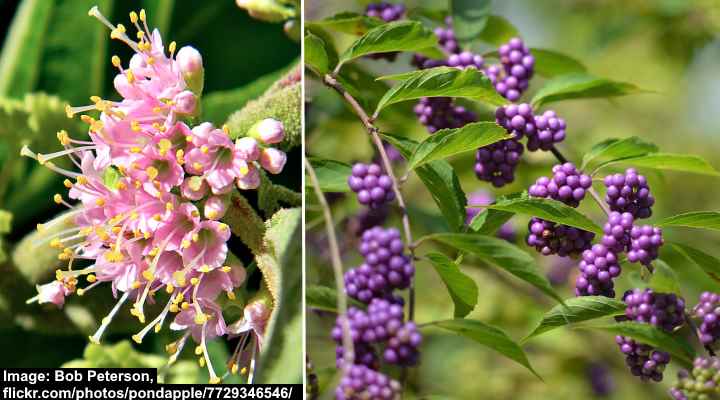
Native to Florida, Beautyberry is an eye-catching shrub known for its magenta or bright violet berries. Beautyberry clusters of pink, white, or purple flowers grow on arching stems among large, light green leaves. This native shrub keeps its showy purple berries throughout winter after the leaves have dropped.
Beautyberry thrives in USDA zones 6 to 11, making it suitable for planting in all of Florida’s regions. The attractively rounded beautyberry shrub grows 3 to 6 ft. (1 – 1.8 m) tall and wide. Landscaping uses for the shrub include a decorative screen or hedge, back of the border shrub, or specimen plant.
Florida Native Plant Identification
Beautyberry is a deciduous native shrub, identified by its arching woody branches. It has clusters of pink, white, or purple flowers, lush green foliage, and vibrant purple berries. Some beautyberry shrubs produce spectacular pure white berries.
- USDA Growing Zone: 6 to 11.
- Sun Exposure: Beautyberry can tolerate both sun and partial shade.
- Soil Needs: Well-draining soil.
- Water Needs: Regular watering is advisable.
- Mature Size: Beautyberry typically grows to a height of 3 to 6 feet (1 – 1.8 meters) and can have a similar spread.
Coontie (Zamia integrifolia)
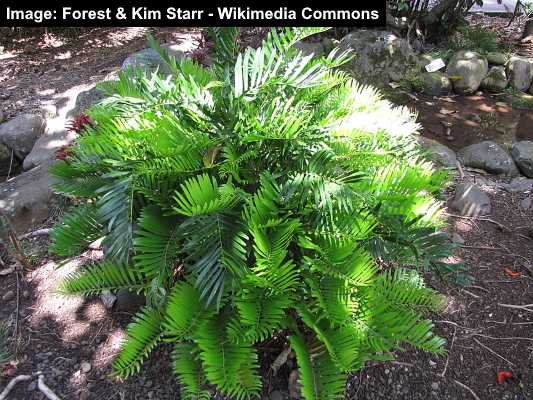
Coontie is a type of cycad with large feather-like evergreen leaves growing in large clumps. The attractive feature of coontie is its pinnately compound large leaves growing up to 3 ft. (1 m) long, each having up to 30 pairs of slender leaflets. It is tolerant of salt air and drought, making it ideal for coastal gardens.
Coontie is unique because it’s the only cycad native to North America. This Florida plant forms a multi-branched cluster that makes it perfect for evergreen landscapes. You can grow the fern-like plant in the sun or shade as a foundation planting, low-growing hedge, or to add structure to your landscape.
Suitable for growing in all regions of Florida, apart from the Panhandle and near the Georgia border.
Florida Native Plant Identification
The identification features of coontie are its large, leathery evergreen leaves that look like palm tree leaves. The cycad has a distinctive clumping habit and grows 1 to 3 ft. (0.3 – 1 m) tall.
- USDA Growing Zone: Suitable for all regions of Florida, apart from the Panhandle and near the Georgia border.
- Sun Exposure: Can tolerate both sun and shade.
- Soil Needs: Well-draining soil is generally preferred for coontie.
- Water Needs: Coontie typically prefers moderate water levels.
Florida Hobblebush (Agarista populifolia)
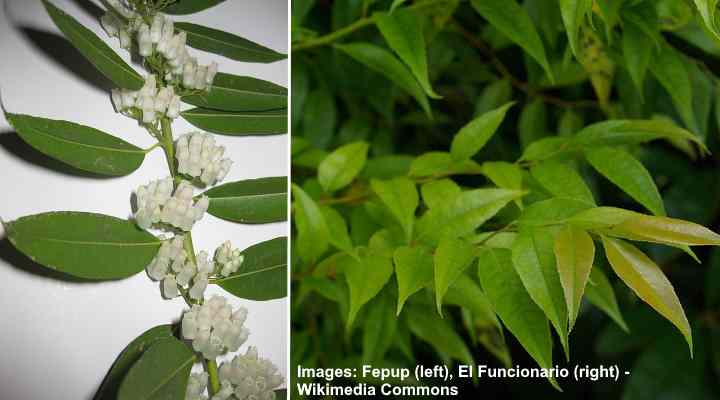
Florida hobblebush is a native evergreen shrub with masses of fragrant white flowers appearing in late spring and summer. The white tubular flowers contrast beautifully with green lanceolate leaves growing on arching branches. After the bell-shaped flowers finish, small round brown seed pods appear.
Also called tall fetterbush, this flowering shrub is suitable for landscaping in North and Central Florida (USDA zones 7 to 9). With its weeping habit, the large shrub grows 8 to 12 ft. (2.4 – 3.6 m) tall and up to 6 ft. (1.80 m) wide.
Florida Native Plant Identification
Florida hobblebush is a multi-stemmed, suckering shrub with eye-catching clusters of white tubular flowers and leaves resembling laurel leaves. New foliage emerges with copper red tinges before turning rich green.
- USDA Growing Zone: USDA zones 7 to 9.
- Sun Exposure: partial shade to full shade.
- Soil Needs: Best grown in well-draining soil.
- Water Needs: Regular watering is recommended.
Oakleaf Hydrangea (Hydrangea quercifolia)

Oakleaf hydrangea is a white-flowering deciduous shrub native to woodlands in the southeastern United States. This hydrangea shrub has several ornamental features. These include its large conical flowering blooms with four-petalled white flowers, deeply lobed leaves that turn russet in the fall, and cinnamon-brown exfoliating bark.
Oakleaf hydrangea is a hardy and versatile shrub that is easy to grow in USDA zones 5 through 9. The flowering shrub grows 6 to 8 ft. (1.8 – 2.5 m) tall and wide. Landscaping uses for the plant are as a hedge, foundation planting, screening, shrub border, or accent plant. Grow in full sun or partial shade.
Florida Native Plant Identification
Characteristics of the oakleaf hydrangea include its large cone-like creamy-white flowers, dense foliage of maple-like leaves, and striking fall colors. The magnificent flowering cones measure up to 12” (30 cm) tall.
- USDA Growing Zone: Zones 5 through 9.
- Sun Exposure: Oakleaf hydrangea can typically grow in full sun to partial shade.
- Soil Needs: Well-draining soil is generally recommended.
- Water Needs: moderate watering.
Firebush (Hamelia patens)
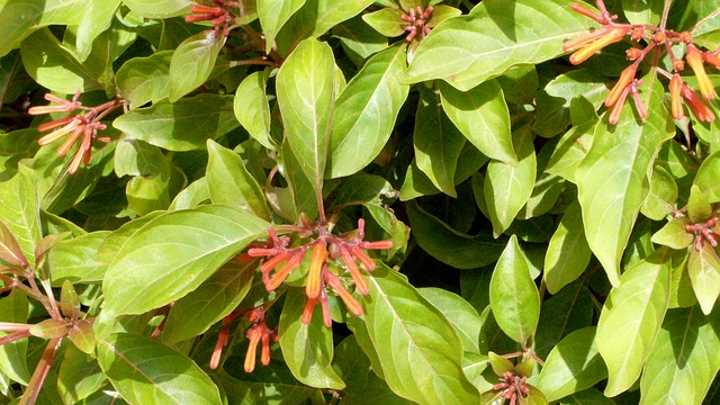
Firebush is a beautiful, fast-growing shrub that thrives in Central and South Florida. This large native shrub produces gorgeous forking clusters of bright red or orange tubular flowers. These spectacular flowers bloom throughout the season and contrast nicely with glossy green foliage, followed by black, glossy berries in the fall.
Also called the firecracker shrub or Mexican firecracker, the sun lover is drought-tolerant in USDA zones 9 to 11. You can grow the large shrub as a flowering hedge, foundation planting, or specimen plant. It’s an ideal choice for adding displays of vibrant color to your garden or landscape all year round.
Florida Native Plant Identification
The identifying features of firebush are its bright red or orange tubular flowers measuring up to 1.5” (4 cm) long, glossy green lanceolate leaves growing 6” (15 cm) long, and clusters of black berries. The large shrub grows 2 to 15 ft. (0.6 – 4.5 m) tall and wide with an upright habit.
- USDA Growing Zone: USDA zones 9 to 11.
- Sun Exposure: Full sun.
- Soil Needs: Well-draining soil is preferred.
- Water Needs: It is considered drought-tolerant once established.
Chapman’s Azalea (Rhododendron chapmanii)
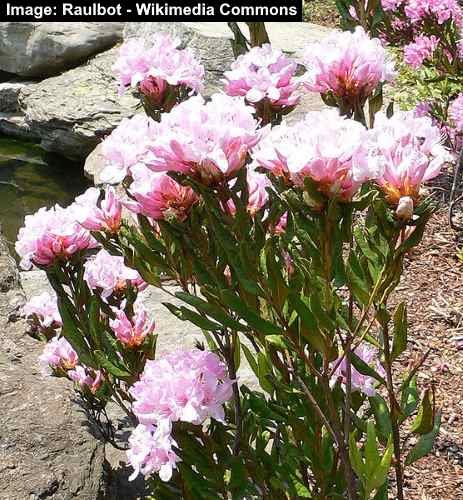
Chapman’s azalea is the only rhododendron species native to Florida. This attractive evergreen azalea shrub grows naturally in the Panhandle and Clay county. Chapman’s azalea has an upright, erect habit with masses of showy pink flowers on display in spring. The shade-loving shrub thrives in USDA zones 7 to 9 and tolerates wetlands.
Endemic to Florida, Chapman’s azalea grows 3 to 6 ft. (1 – 1.8 m) tall and wide.
Florida Native Plant Identification
The identifying features of Chapman’s azalea are its showy pink, funnel-shaped flowers growing in clusters of 4 to 12 blooms. The five-petaled flowers measure 4” (10 cm) long.
- USDA Growing Zone: USDA zones 7 to 9.
- Sun Exposure: Partial to full shade.
- Soil Needs: Well-draining soil is generally recommended.
- Water Needs: Adequate moisture is important.
Scarlet Hibiscus (Hibiscus coccineus)
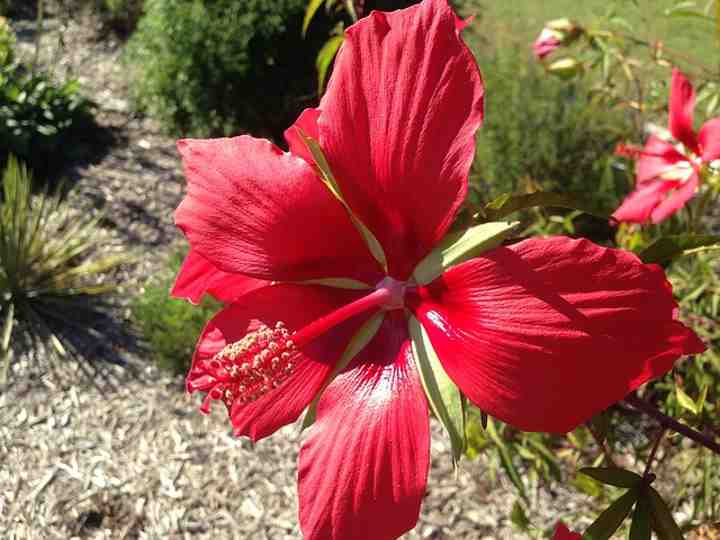
Also called American scarlet rose mallow, this red-flowering perennial shrub is known for its crimson red flowers, palmately divided green leaves, and upright habit. Suitable for growing in all Florida regions from the Panhandle to Fort Myers, this long-blooming shrub grows 3 to 6 ft. (1 – 1.8 m) tall and 3 ft. (1 m) wide.
Scarlet hibiscus shrubs are ideal for USDA zones 6 to 9. In addition, the hibiscus shrubs are ideal for decorating shrub borders, foundation lines, or backyards with showy summer blooms.
Florida Native Plant Identification
Scarlet hibiscus is identified by its five-petaled large crimson red flowers measuring up to 3” to 5” (7.5 – 12 cm) across. The large shrub has palmately divided green leaves growing up to 8” (20 cm) long and wide.
- USDA Growing Zone: USDA zones 6 to 9
- Sun Exposure: Full sun to partial shade.
- Soil Needs: Well-draining soil is generally recommended.
- Water Needs: Adequate watering is important.
Privet Senna (Senna ligustrina)
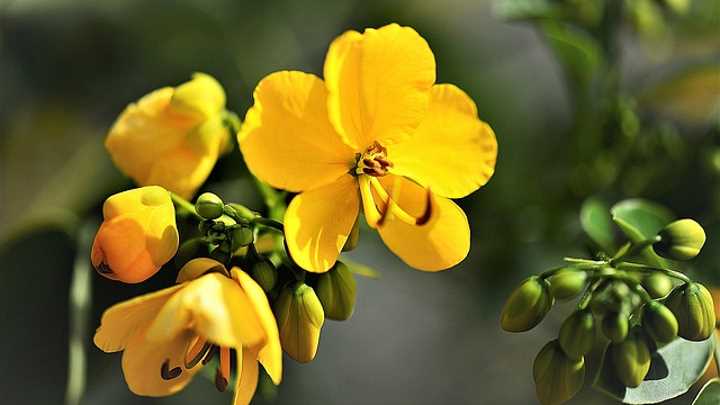
Native to Southwest Florida, the privet senna evergreen shrub has outstanding bright yellow flowers and attractive foliage of lance-shaped leaves. Privet senna grows in full sun and moist, well-drained soils. The Florida shrub blooms from fall to spring and sometimes through summer—filling yards with yellow and green colors.
Privet senna grows 4 to 8 ft. (1.2 – 2.4 m) tall and 6 ft. (1.8 m) wide. The native shrub thrives in all areas of Florida south of Gainesville. It even tolerates the tropical conditions of the Florida Keys.
- USDA Growing Zone: Suitable for all areas of Florida south of Gainesville.
- Sun Exposure: Full sun is usually preferred.
- Soil Needs: Well-draining .
- Water Needs: Regular watering is recommended.
Florida Native Plant Identification
Privet senna is a low-maintenance landscape plant. It is identified by its five-petalled flowers growing in clusters of five to ten brightly-colored yellow blooms. After flowering, thin, 5” (12 cm) long slender seed pods appear among the dark green pinnately compound leaves.
Saw Palmetto (Serenoa repens)
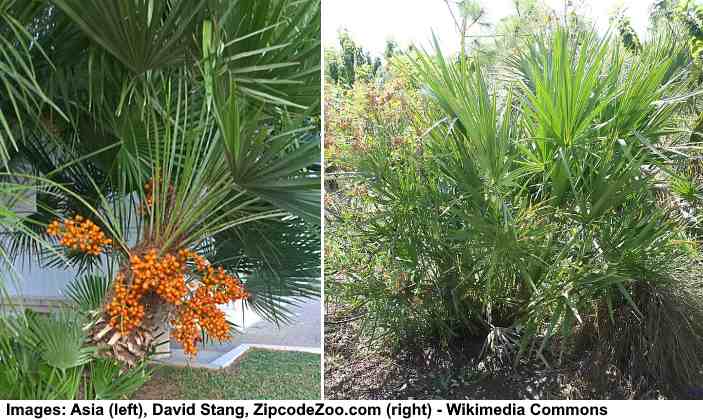
Saw palmetto is a native Florida palm with shrub-like growth. The fan-shaped evergreen palm leaves have 18 to 30 pointed segments and can grow up to 3 ft. (1 m) in diameter. The fan leaves grow on the ends of spiny petioles. In addition to evergreen foliage, this shrubby palm plant has creamy-white flowers followed by yellow berries.
Native to peninsular Florida, saw palmetto is a shrub-like palm that grows 5 to 10 ft. (1.5 – 3 m) tall and wide. Its tolerance to salt and drought makes it ideal for ground cover, mass plantings, or a security barrier in seaside and coastal landscapes.
Florida Native Plant Identification
Saw palmetto is easily identified by its characteristic fan-shaped leaves growing on thorny stems, creating a large mass of spiky evergreen foliage.
- USDA Growing Zone: USDA zones 8 to 10.
- Sun Exposure: Full sun.
- Soil Needs: Well-draining sandy soil.
- Water Needs: It can tolerate drought once established.
Wild coffee (Psychotria nervosa)
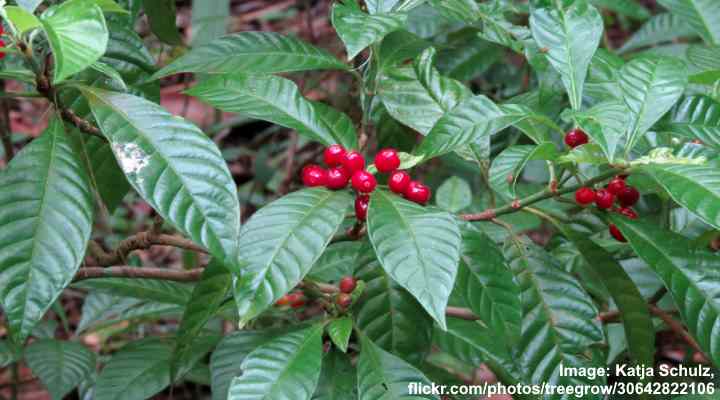
Wild coffee is a tropical shrub native to Florida. It is known for its glossy dark green evergreen leaves and brilliant red berries. The attractive ornamental feature of the shrub is its puckered leaves giving the shiny foliage a unique wavy appearance. In addition, the shrub has clusters of small whitish tubular flowers followed by shiny edible red berries.
Wild coffee shrubs are the most widely cultivated of Florida’s native shrubs. Ideally suited for Florida, the shrub thrives in USDA zones 9 to 11 and is tolerant of drought and coastal sea air. In addition, wild coffee plants are one of the few native Florida shrubs that thrive in the shade.
Florida Native Plant Identification
Wild coffee is a popular native shrub due to its large glossy green, obovate leaves measuring 6” (15 cm) long, clusters of white star-shaped flowers, and vibrant red berries. The large shrub grows 2 to 10 ft. (0.6 – 3 m) tall and 5 ft. (1.5 m) wide.
- USDA Growing Zone: USDA zones 9 to 11.
- Sun Exposure: Typically grown in shade.
- Soil Needs: Well-draining soil.
- Water Needs: Regular watering is advisable.
Cardinal Spear (Erythrina herbacea)
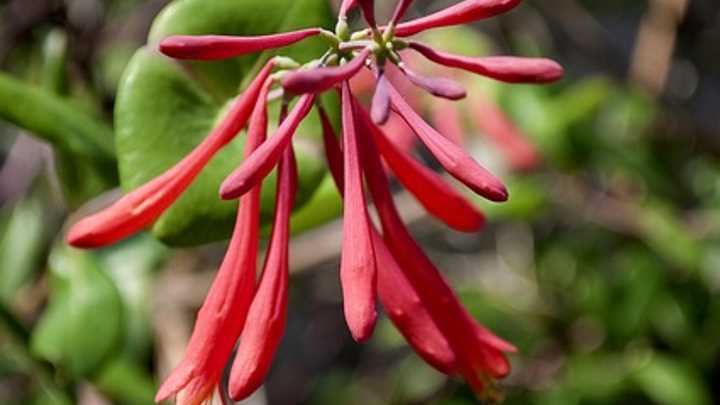
Cardinal spear is a striking perennial shrub with bright red, tubular flowers that bloom in late spring and summer. Native to the southeastern United States, cardinal spear is identified by its arrow-shaped, glossy green leaves, thorny stems, and showy, long-blooming red flowers that thrive in full sun.
Cardinal spear is a low-maintenance shrub ideal for gardens in North and Central Florida. The red-flowering shrub performs well as a drought-tolerant ornamental shrub, foundation planting, or privacy screening. Its sharp, spiny branches and dense foliage make it ideal for security hedge.
- USDA Growing Zone: 6 to 9
- Sun Exposure: Full sun or partial shade
- Mature Size: 6 to 12 ft. (1.8 – 3.6 m) tall and up to 6 ft. (1.8 m) wide
- Soil Needs: Well-drained sandy or loamy soil
- Water Needs: Moderate watering needs and good drainage
Gopher Apple (Geobalanus oblongifolius)

Gopher apple is a low-growing evergreen shrub identified by its small white flowers in summer and leathery green leaves. Growing less than a foot (30 cm) tall, the evergreen bushy plant has clusters of creamy white flowers, small pink, purple, or red fruits, and oblong leaves. Its spreading nature makes it ideal for ground cover.
Native to Florida, the gopher apple is a tough, hardy plant well-adapted to hot, humid climates. The small shrub is tolerant of salt, drought, and fire, making it a fantastic addition to coastal, tropical landscapes. The ripe fruits attract gopher mammals and tortoises, hence its common name.
- USDA Growing Zone: 8 to 11
- Sun Exposure: Full sun
- Mature Size: 3” to 12” (7.5 – 30 cm) tall spreads to form large colonies
- Soil Needs: Well-drained sandy soils
- Water Needs: Low needs and tolerant of drought
Native Azaleas (Rhododendron spp.)
Native azaleas are beautiful flowering shrubs that thrive throughout Florida. The bushy plants are identified by their fragrant funnel-shaped flowers with ruffled petals and prominent stamens. The clusters of showy flowers bloom in spring and early summer in pink, orange, red, and white shades. Depending on the variety, Florida azaleas can be deciduous or evergreen.
Here are a few azalea varieties that thrive in Florida’s hot and humid climate:
Florida flame azalea (Rhododendron austrinum): This azalea is a shade-loving shrub that produces stunning orange to golden-yellow funnel-shaped blooms. The spring-blooming shrub grows 5 to 6 ft. (1.5 – 1.8 m) tall and up to 4 ft. (1.2 m) wide. Suitable for all parts of Florida.
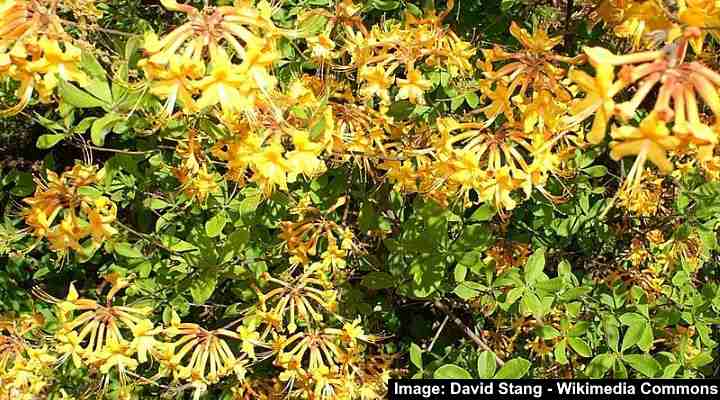
Florida flame azalea (Rhododendron austrinum)
Mountain azalea (Rhododendron canenscens): Native to the southeastern US, the large deciduous shrub is identified by its funnel-shaped, fragrant pale pink flowers growing in clusters of five to nine blossoms. The shrub thrives in partial shade in North and Central Florida, growing up to 8 ft. (2.4 m) tall.
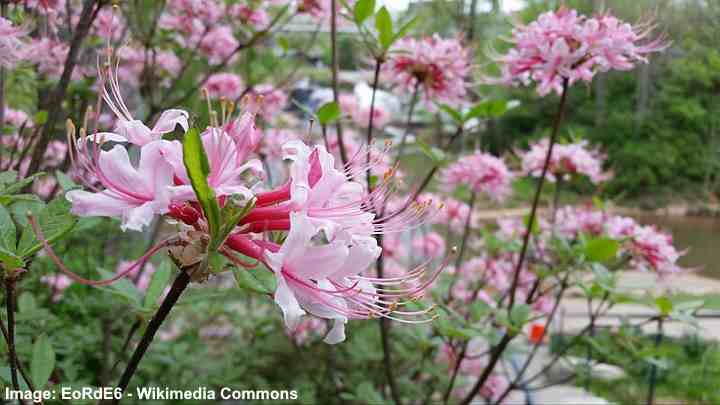
Mountain azalea (Rhododendron canenscens)
Aromi Sunrise azalea (Rhododendron ‘Aromi Sunrise’): Although not native to Florida, it’s one of the few azaleas hybrids that thrive in the coastal South. This variety has stunning honeysuckle-like orange flowers contrasting with emerald-green foliage. It grows 4 to 6 ft. (1.2 – 1.8 m) tall and wide.

Aromi Sunrise azalea (Rhododendron ‘Aromi Sunrise’)
- USDA Growing Zone: Varies depending on species, but generally 4 to 9
- Sun Exposure: Partial shade
- Soil Needs: Acidic, well-draining soils
- Water Needs: Consistently moist soil
- Mature Size: Varies depending on species, but typically 4 to 6 ft. (1.2 to 1.8 m) tall
Necklace Pod (Sophora tomentosa)

Necklace pod is a tropical shrub known for its clusters of bright yellow flowers, small silvery-gray oval leaves, and long beaded seed pods. Native to South Florida, the sun-loving shrub blooms throughout the year. Its yellow blooms are showy long spikes, and the necklace-like pods grow 6” (15 cm) long.
Necklace pod is a versatile, fast-growing plant ideal for growing in Florida’s coastal landscape and near marine swamps. It grows up to 10 ft. (3 m) tall and is tolerant of salt spray, heat, wind, and drought. It attracts hummingbirds, butterflies, and native bees to gardens.
- USDA Growing Zone: 9 to 11
- Sun Exposure: Full sun
- Mature Size: 6 to 10 ft. (1.8 – 3 m) tall and 8 to 12 ft. (2.4 – 3.6 m) wide
- Soil Needs: Well-drained, sandy soils and tolerates dry, salty soil
- Water Needs: Moderate watering during summer
Star Anise (Illicium)

Florida anise (Illicium floridanum)
Star anise is a small evergreen shrub native to the Southeastern US and blooms in spring and summer. This shade lover is known for its ornamental star-shaped cream, yellow, or red flowers, star-shaped aromatic fruits, and lanceolate leaves. The easily recognizable feature of the plant is its seeds with a strong, licorice or anise-like flavor.
Star anise shrubs are shade-loving plants for Florida’s unforgiving climate. They thrive in coastal areas and tolerate soggy soil. Landscaping uses for star anise shrubs include planting as a hedge, border, or foundation planting.
- USDA Growing Zone: 6 to 10
- Sun Exposure: Dappled sunlight, partial shade, full shade
- Mature Size: 1 to 20 ft. (0.3 – 6 m) tall
- Soil Needs: Well-drained loamy or sandy soil
- Water Needs: Moderate watering, and tolerates moist, occasionally wet conditions.
Walter’s Viburnum (Viburnum obovatum)
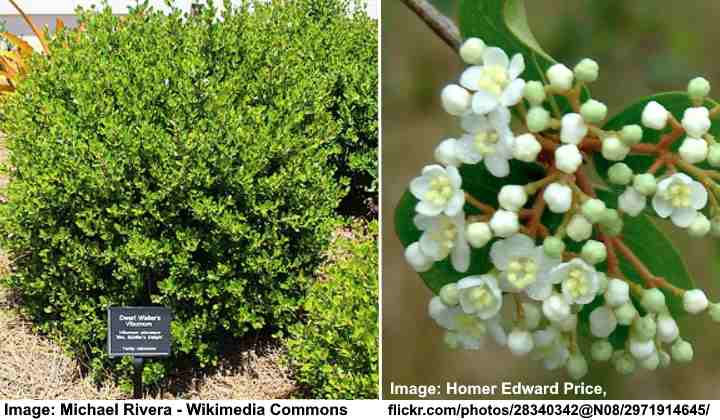
Walter’s viburnum is a versatile white-flowering shrub that is a great addition to Florida landscapes. It’s a shrubby plant identified by its clusters of fragrant white flowers that bloom in spring, glossy, dark green leaves, and small blue-black berries that attract birds and wildlife. It has a dense, rounded habit.
Walter’s viburnum, can be pruned to form a small tree-like shape. With proper pruning and training, you can encourage a single trunk and a more tree-like growth habit, rather than its natural multi-stemmed shrub form.
Walter’s viburnum is a tough and adaptable native Florida plant that is evergreen throughout the Sunshine State. You can grow the attractive shrubs as a hedge, privacy screen, foundation planting, or specimen plant.
- USDA Growing Zone: 7 to 10
- Sun Exposure: Full sun or partial shade
- Mature Size: 6 to 30 ft. (1.8 – 9 m) tall and 6 to 12 ft. (1.8 – 3.6 m) wide
- Soil Needs: Fertile, acidic soil types
- Water Needs: Average water needs, drought tolerant once established
Darrow’s Blueberry (Vaccinium darrowii)

Darrow’s blueberry is a small, fruit-producing shrub with small, pointed green leaves, pinkish-white, bell-shaped flowers, and delicious blueberries. Native to the southeast, this heat-tolerant shrubby plant grows up to 2 ft. (0.6 m) tall, making it ideal for compact landscapes. It blooms in early spring, followed by blueberries in late spring.
This blueberry shrub is low-maintenance and requires minimal pruning. In Florida backyards, the shrub performs well as a low hedge, border plant, or specimen plant. It also thrives in small gardens or containers. It grows throughout Florida in the wild in pine forests.
- USDA Growing Zone: 8 to 10
- Sun Exposure: Full sun to partial shade
- Mature Size: 2 ft. (0.6 m) tall and wide
- Soil Needs: Acidic soil with good drainage
- Water Needs: Regular watering, especially during dry spells
Bahama Cassia (Cassia bahamensis)
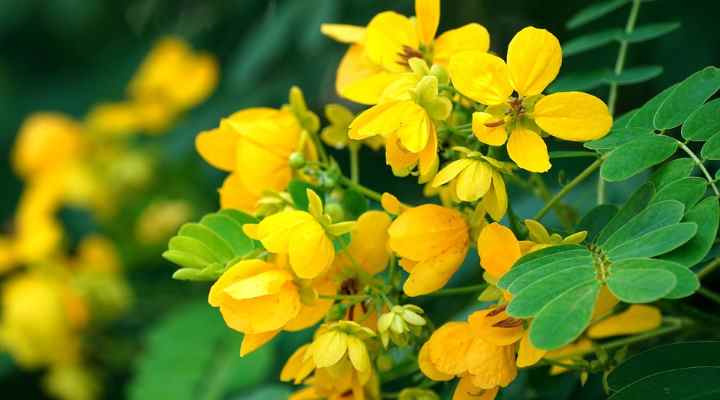
Bahama cassia is a native shrub identified by its beautiful yellow flowers that bloom in winter. The sweet-smelling flowers contrast with the luscious dark green foliage, followed by showy, long brown seed pods 6” (15 cm) long. The vibrant yellow five-petalled blooms measure 1” (2.5 cm) wide.
Bahama cassia thrives in South Florida, growing in partially shaded conditions. The shrub is great for adding color to a tropical landscape garden or planting along a fence or pathway. It also performs well as a hedge, border, or privacy screen.
- USDA Growing Zone: 10 and 11
- Sun Exposure: Partial shade
- Mature Size: 3 to 9 ft. (1 – 2.7 m) tall and 6 to 10 ft. (1.8 – 3 m) wide
- Soil Needs: Most soil types that drain well
- Water Needs: Moderate watering; however, it has a high drought tolerance
Buttonsage (Lantana involucrata)

Buttonsage is an evergreen shrub that thrives in sunny South Florida landscapes. The woody shrub is identified by its clusters of sweet-smelling white to lavender flowers, aromatic leaves, and purplish-black berries. Blooming year-long in Florida’s southern gardens, the pretty flowers add color and fragrance and attract butterflies and hummingbirds to the garden.
Buttonsage is a tough, resilient plant native to southern Florida’s dunes and coastal strands.
- USDA Growing Zone: 8 to 11
- Sun Exposure: Full sun
- Mature Size: 3 to 5 ft. (1 – 1.5 m) tall and wide
- Soil Needs: Sandy, dry, well-draining soils
- Water Needs: Drought-tolerant and low watering needs
Native Florida Trees
Native Florida trees are suitable for growing in USDA zones 8 to 11 and are vital for shade, privacy, and greenery in residential landscapes. From majestic live oaks to attractive maple trees and fragrant magnolias, there is a wide variety of native trees that thrive in Florida.
Florida Maple (Acer saccharum subsp. floridanum)
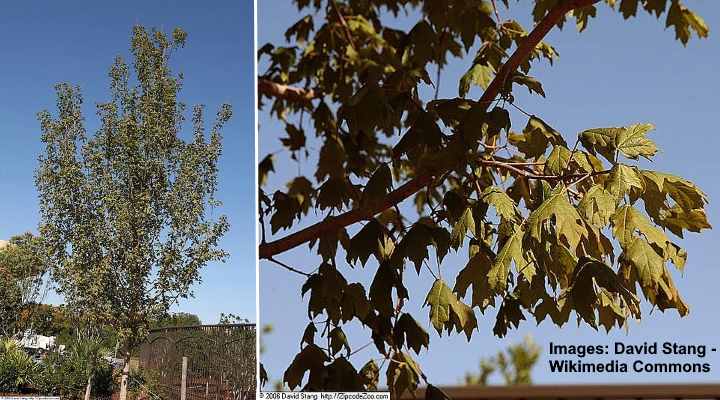
The Florida maple is a large, leafy deciduous tree perfect for shade in southern states. A Florida maple tree has a rounded crown with characteristic maple leaves with three to five rounded lobes. The tree’s outstanding decorative feature is its stunning red, orange, and yellow fall colors.
Additionally, this species of maple has light gray bark, clusters of yellowish flowers, and two-singed papery seed pods. The Florida maple is a low-maintenance, drought-tolerant tree in USDA zones 6 through 9.
Florida Native Plant Identification
Identifying features of the Florida maple are its rounded crown of dense foliage, dark green leaves that turn into warm autumn shades, and light gray bark. It grows 20 to 60 ft. (6 – 18 m) tall and 25 to 40 ft. (7 – 12 m) wide.
- USDA Growing Zone: Zones 6 to 9
- Sun Exposure: Full sun to partial shade
- Soil Needs: Well-drained, moist soil
- Water Needs: Regular watering
- Mature Size: 20 to 60 feet tall, 25 to 40 feet wide
Native Florida Pine Trees
Several species of pine trees are native to Florida. Native southeastern pines tolerate the warm, humid climate and thrive in sandy soils. Surprisingly, some native pines will perform well as far south as the Florida Keys.
Here are the identification features of four popular native species of Florida pine trees:
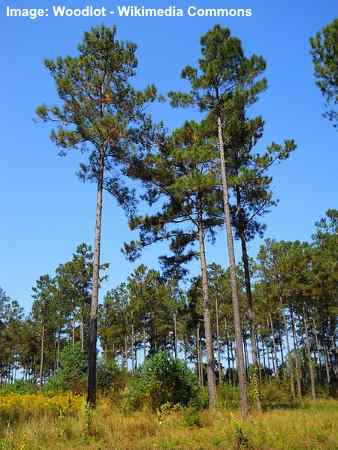
Loblolly pine (Pinus taeda)
Loblolly Pine Tree (Pinus taeda): This fast-growing pine has clusters of yellowish-green needle leaves, conical pine cones, and grayish bark. The loblolly pine grows 90 to 100 ft. (27 – 30 m) tall in USDA zones 6 to 9.

Slash pine (Pinus elliottii)
- USDA Growing Zone: Zones 6 to 9
- Sun Exposure: Full sun
- Soil Needs: Well-drained, sandy soil
- Water Needs: Moderate moisture
- Mature Size: 90 to 100 feet tall
Slash Pine Tree (Pinus elliottii): This native Florida pine thrives throughout the state, including areas south of Miami. The pine has dark green needles 5” to 11” (13 – 28 cm) long and long brown, egg-shaped cones. The pine tree grows 60 to 100 ft. (18 – 30 m) tall in USDA zones 8 to 11.
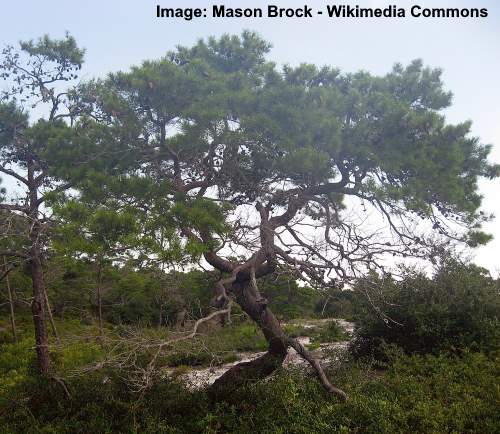
Sand pine (Pinus Clausa)
- USDA Growing Zone: Zones 8 to 11
- Sun Exposure: Full sun
- Soil Needs: Well-drained, sandy soil
- Water Needs: Moderate moisture
- Mature Size: 60 to 100 feet tall
Sand Pine (Pinus clausa): This small native coniferous tree has distinctive twisting branches, cylindrical brown pine cones, and needle leaves growing in pairs. The heat-loving native pine grows 16 to 33 ft. (5 – 10 m) tall in USDA zones 9 and 10.
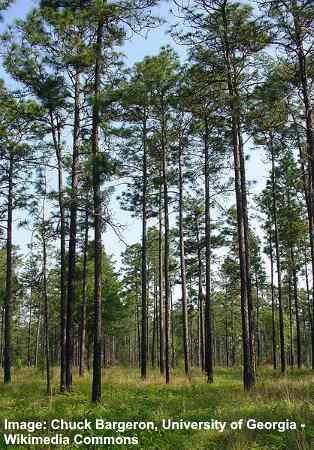
Longleaf pine (Pinus palustris)
- USDA Growing Zone: Zones 9 and 10
- Sun Exposure: Full sun
- Soil Needs: Sandy, well-drained soil
- Water Needs: Drought-tolerant once established
- Mature Size: 16 to 33 feet tall
Longleaf Pine Tree (Pinus palustris): The distinctive feature of this pine tree is its exceedingly long pine needles. The tall, elegant native conifer has needle leaves 18” (45 cm) long and pine cones 10” (25 cm) long. It thrives in USDA zones 7 through 10 and grows 120 ft. (36 m) tall.
- USDA Growing Zone: Zones 7 to 10
- Sun Exposure: Full sun
- Soil Needs: Well-drained sandy soils
- Water Needs: Drought-tolerant once established
- Mature Size: 120 feet tall
Native Florida Oak Trees
Oak trees are some of the most elegant hardwood trees to thrive in Florida. The majestic oaks are identified by their wide, spreading crowns, gray bark, and oval leaves with deep, rounded, or bristle-tipped lobes. Here are descriptions of three of the 19 oak trees native to Florida.
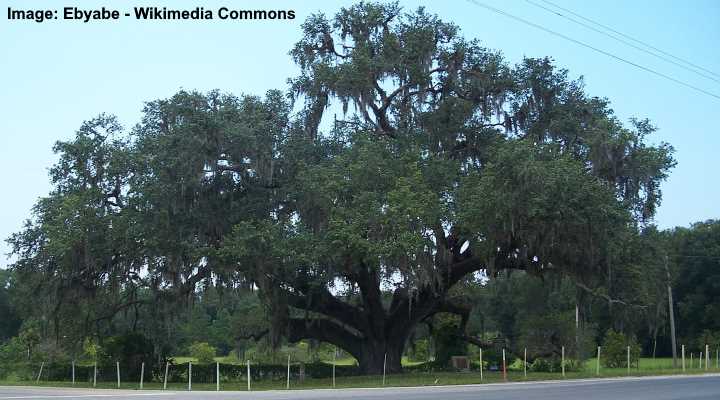
Live oak tree (Quercus virginiana)
Southern live oak (Quercus virginiana): This evergreen oak tree is identified by its leathery, dark green oblong leaves and egg-shaped black acorns. Southern live oaks are easily recognizable in the landscape due to their sprawling canopy and twisting branches. The live oak grows 40 to 80 ft. (12 – 24 m) tall and up to 100 ft. (30 m) wide in zones 8 to 10.
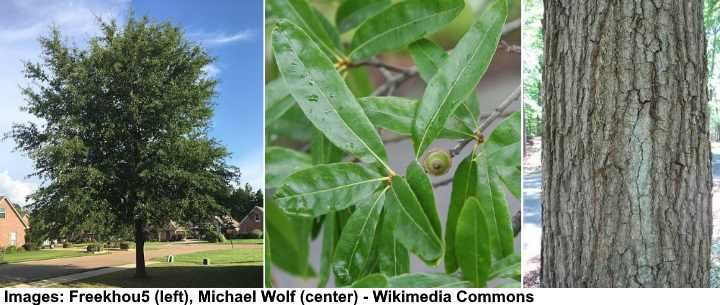
Willow oak tree, leaves and bark
- USDA Growing Zone: Zones 8 to 10
- Sun Exposure: Full sun to partial shade
- Soil Needs: Well-drained soil
- Water Needs: Moderate to high moisture
- Mature Size: 40 to 80 feet tall, up to 100 feet wide
Willow oak (Quercus phellos): This native Florida oak tree has long, narrow leaves, brown acorns sitting in a greenish-tan cap, and rough, gray, furrowed bark. The fast-growing willow oak tree grows 65 to 100 ft. (20 – 30 m) tall in Northern and Central Florida (USDA zones 5 to 9).
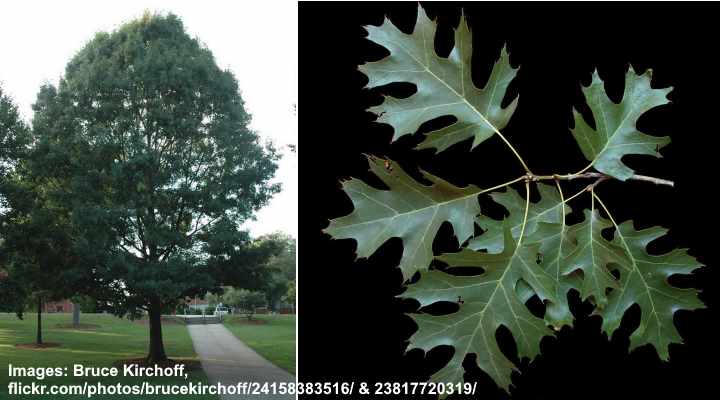
Shumard oak tree (Quercus shumardii)
- USDA Growing Zone: Zones 5 to 9
- Sun Exposure: Full sun to partial shade
- Soil Needs: Well-drained soil
- Water Needs: Moderate moisture
- Mature Size: 65 to 100 feet tall
Shumard oak (Quercus shumardii): Ideal for growing in North and Central Florida, the Shumard oak has large leaves with pointed lobes, large dark-brown acorns, and reddish-brown bark. The native red oak tree grows 50 to 70 ft. (15 – 21 m) tall and up to 40 ft. (12 m) wide in USDA zones 5 to 9.
- USDA Growing Zone: Zones 5 to 9
- Sun Exposure: Full sun to partial shade
- Soil Needs: Well-drained soil
- Water Needs: Moderate moisture
- Mature Size: 50 to 70 feet tall, up to 40 feet wide
Native Florida Palm trees
Florida is home to several native palm tree species. Many of these native palms are characteristic of the skylines of Miami, Naples, Fort Lauderdale, and Tampa. In addition, these tropical plants thrive in coastal areas along the Gulf of Mexico and the Atlantic Ocean.
Here are two popular varieties of native Florida palm trees:
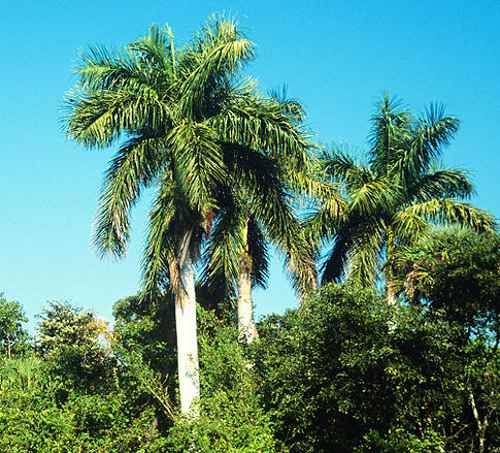
Florida Royal Palm (Roystonea regia)
Florida Royal Palm Tree (Roystonea regia): This exotic native palm has a tall, slender trunk with smooth gray bark and a huge crown of large, feathery fronds. The enormous bright green leaves grow 13 ft. (4 m) long. This palm is one of the most beautiful palm trees in the world. It grows 65 to 100 ft. (20 – 30 m) tall in zones 10 and 11.
- USDA Growing Zone: Zones 10 and 11
- Sun Exposure: Full sun
- Soil Needs: Well-drained soil
- Water Needs: Moderate moisture
- Mature Size: 65 to 100 feet tall
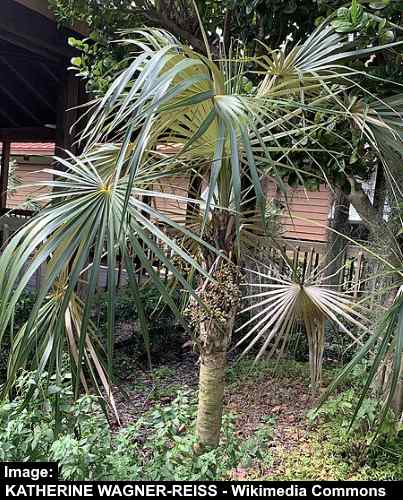
Florida Silver Palm (Coccothrinax argentata)
Florida Silver Palm (Coccothrinax argentata): This small palm is native to Southern Florida and is identified by its fan-shaped leaves, white flower clusters, and purple-black palm fruits. The native palm thrives in zones 10 and 11 and grows up to 5 to 20 ft. (1.5 – 6 m) tall.
- USDA Growing Zone: Zones 10 and 11
- Sun Exposure: Full sun
- Soil Needs: Well-drained soil
- Water Needs: Moderate moisture
- Mature Size: 5 to 20 feet tall
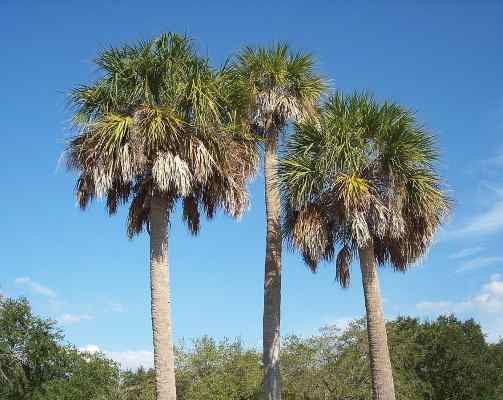
Sabal palm (Sabal palmetto): The Sabal palm, also known as the “Cabbage Palm,” is a native Floridian tree and an iconic symbol of the state. It has been officially designated as the state tree of Florida.
This native Sabal palm tree is recognized by its fan-shaped fronds, which can grow up to six feet in length, adding a tropical touch to the environment. It has a slender trunk, typically covered with the remnants of old fronds, giving it an elegant appearance.
One of its most remarkable features is its resilience. The Sabal palm is well-suited to Florida’s challenging climate, capable of enduring strong winds, salt spray, and other harsh conditions. Its ability to withstand hurricanes and tropical storms has earned it the reputation of being a symbol of Florida’s natural beauty and strength.
In terms of height, Sabal palms can grow to impressive sizes, often reaching heights of 50 to 70 feet. These towering palm trees are a prominent fixture in Florida’s landscapes, providing both aesthetic beauty and a sense of endurance, mirroring the spirit of the Sunshine State.
- USDA Growing Zone: 8 to 11
- Sun Exposure: This native tree prefers full sun to partial shade
- Soil Needs: Sabal palms are adaptable to a variety of soil types, including well-draining sandy soil, loamy soil, and clay soil. They are often found growing in coastal areas and are tolerant of salt spray
- Water Needs: Once established, Sabal palms are drought-tolerant and can withstand periods of dry weather. However, regular watering can help promote healthy growth, especially in the early stages
- Mature Size: The Sabal palm is a tall and stately tree, reaching an impressive mature height of up to 65 feet (20 meters) with a spread of about 10 to 15 feet (3 to 4.5 meters)
Red Buckeye (Aesculus pavia)
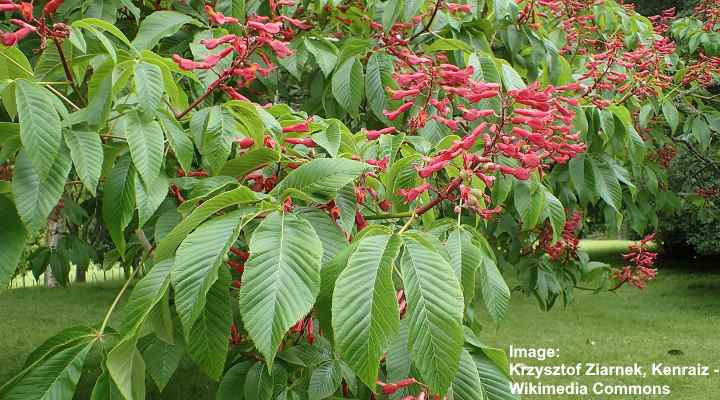
Also called the Florida buckeye, this native flowering tree is easily recognizable in spring due to its conical clusters of rich red blossoms. The small deciduous tree has large leaves consisting of five leaflets and smooth brown capsules containing one or two buckeye seeds.
Red buckeye grows 12 to 15 ft. (3.6 – 4.5 m) tall and wide. Ideal for growing in Central and Northern Florida, you can plant the small ornamental shrub-like tree as a flowering screen, hedge, or specimen tree. It thrives in USDA zones 5 to 9.
Florida Native Plant Identification
Identifying features of the red Florida buckeye include erect clusters of red tubular flowers growing 6” (15 cm) long, palmate leaves, and gray-brown bark with scaly patches.
- USDA Growing Zone: Zones 5 to 9
- Sun Exposure: Full sun to partial shade
- Soil Needs: Well-drained soil
- Water Needs: Moderate moisture
- Mature Size: 12 to 15 feet tall and wide
Eastern Redbud (Cercis canadensis)
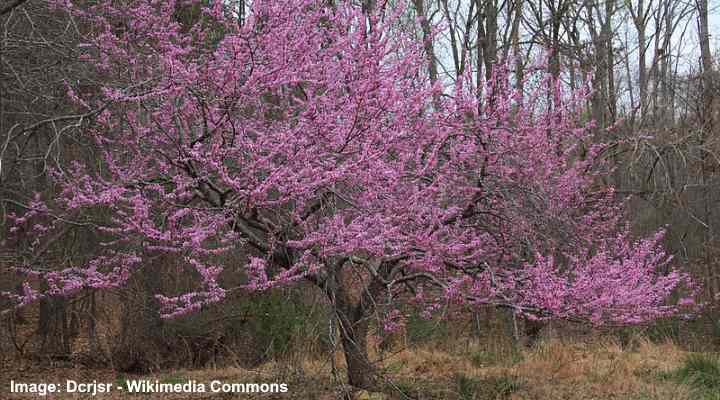
Are you looking for a native flowering tree to produce masses of pink spring flowers in your Florida landscape? If so, the eastern redbud is an ideal choice. It’s famous for its stunning spring blooms that cover bare branches. After flowering, attractive heart-shaped leaves appear, followed by dangling ornamental brown seed pods.
Native to Florida, the ornamental tree, with its twisting branches, grows 20 to 30 ft. (6 – 9 m) tall with a spreading crown up to 35 ft. (10.5 m) wide. Suitable for USDA zones 4 to 9.
Florida Native Plant Identification
The eastern redbud landscaping tree is identified by its heart-shaped leaves, clusters of pink flowers, horizontally growing branches, and rounded crown.
- USDA Growing Zone: Zones 4 to 9
- Sun Exposure: Full sun to partial shade
- Soil Needs: Well-drained soil
- Water Needs: Moderate moisture
- Mature Size: 20 to 30 feet tall, spreading crown up to 35 feet wide
Gumbo-Limbo Tree (Bursera simaruba)

The gumbo-limbo tree thrives in areas of Florida south of Lake Okeechobee. The tropical tree’s decorative features are its reddish bark that peels off in thin strips and white spring flowers followed by diamond-shaped red berries. An unusual feature of the tree is its turpentine aroma when the leaves are crushed.
Thriving in USDA zones 10 and 11, the gumbo-limbo tree grows 25 to 40 ft. (7.5 – 12 m) tall and up to 30 ft. (9 m) wide. Grow in full sun to partial shade in well-drained soils.
Florida Native Plant Identification
The gumbo-limbo semi-evergreen tropical tree is identified by its bronze exfoliating bark, pinnately compound leaves with three to nine leaflets, small triangular red berries, and clusters of drooping white flowers.
- USDA Growing Zone: Zones 10 and 11
- Sun Exposure: Full sun to partial shade
- Soil Needs: Well-drained soil
- Water Needs: Moderate moisture
- Mature Size: 25 to 40 feet tall, up to 30 feet wide
Southern Red Cedar (Juniperus silicicola)

The southern red cedar is a magnificent coniferous tree with evergreen foliage consisting of soft scale-like feathery sprays. Native to Florida, the southern red cedar’s dense foliage makes it ideal as a privacy screen, windbreak, or specimen tree for southern landscapes. Additionally, the versatile tree thrives in various soil conditions.
The southern red cedar grows 30 to 45 ft. (9 – 13 m) and thrives in USDA zones 8 through 10. Its tolerance to sun, humidity, and heat makes it ideal for all areas of Florida, apart from the Florida keys.
Florida Native Plant Identification
Identifying features of the southern red cedar are its conical habit, dense evergreen foliage, scale-like sprays of needles, and reddish-brown bark.
- USDA Growing Zone: Zones 8 through 10
- Sun Exposure: Full sun to partial shade
- Soil Needs: Well-drained soil
- Water Needs: Moderate moisture
- Mature Size: 30 to 45 feet tall
Southern Magnolia (Magnolia grandiflora)
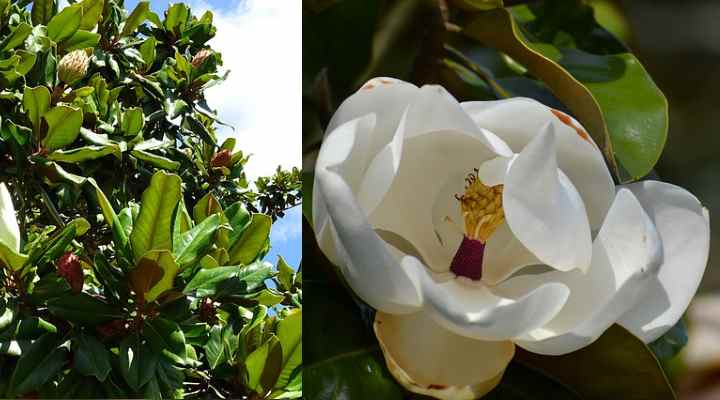
One of the most attractive flowering native evergreen trees in Florida is the southern magnolia. The sun-loving tree has creamy-white fragrant, cup-shaped flowers, tough, leathery leaves, and cone-like seed pods. This long-lived, fast-growing tree is a popular ornamental and shade tree in the South and subtropical climates.
The southern magnolia thrives in USDA zones 7 to 10 and grows 60 to 80 ft. tall and up to 50 ft. wide. The low-maintenance white-flowering tree is a stunning specimen plant in the Southeast.
Florida Native Plant Identification
Identifying features of the southern magnolia tree are its pyramidal, rounded crown, glossy dark green leaves, fragrant white flowers, and cone-like seed pods. When the pods open, silky rose-red seed dangle from the tree.
Related: The Best Magnolia Trees for Florida
- USDA Growing Zone: Zones 7 to 10
- Sun Exposure: Full sun to partial shade
- Soil Needs: Well-drained soil
- Water Needs: Moderate moisture
- Mature Size: 60 to 80 feet tall, up to 50 feet wide
Bald Cypress (Taxodium distichum)
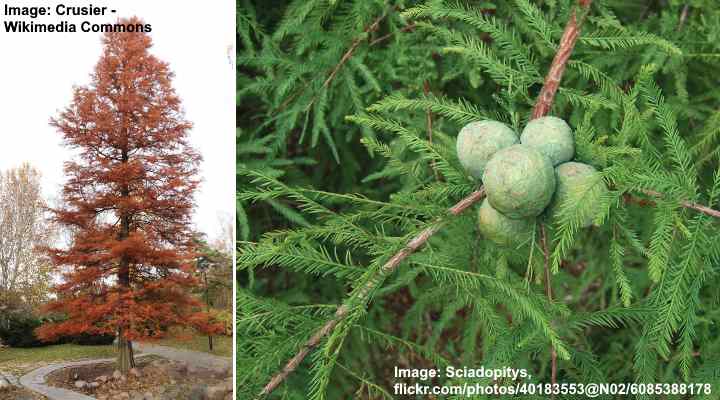
Bald cypress is a deciduous conifer tree with a pyramidal habit thriving throughout all regions of Florida. The unusual conifer has needle-like leaves in the summer before they drop in the winter. Other identifying features are its fibrous, exfoliating brown bark and wider trunk at its base.
The eye-catching feature of the tree is its deciduous lacy needles that turn orange, red, and cinnamon-brown in the fall. Bald cypress trees are commonly found in swampy areas, riverbanks, and wetlands.
- USDA Growing Zone: 5 to 11
- Sun Exposure: Full sun to partial shade
- Mature Size: 50 to 70 ft. (15 – 21 m) tall and up to 30 ft. (9 m) wide
- Soil Needs: Moist to wet, acidic, poorly drained soils
- Water Needs: Tolerant of both wet and dry conditions
Chickasaw Plum (Prunus angustifolia)

Chickasaw plum is a small fruit tree with clusters of tiny white flowers blooming in the spring on bare branches. Native to Florida, the Chickasaw plum tree has smooth red bark, deciduous, bright-green lanceolate leaves, and red, tart fruits. The small shrub-like tree grows up to 20 ft. (6 m) tall.
Chickasaw Plum is a hardy tree that thrives in North and Central Florida. It performs best in sandy soils in partial shade. Unlike many cherry trees, this variety has spiny thorns on its branches. It is also a host plant for one of Florida’s most beautiful butterflies—the red-spotted purple butterfly (Limenitis arthemis astyanax).
- USDA Growing Zone: 5 to 9
- Sun Exposure: Full sun or partial shade
- Mature Size: Up to 20 ft. (6 m) tall and 15 ft. (4.5 m) wide
- Soil Needs: Well-draining, acidic soil
- Water Needs: Require regular watering during dry spells
Southern Wax Myrtle (Morella cerifera)
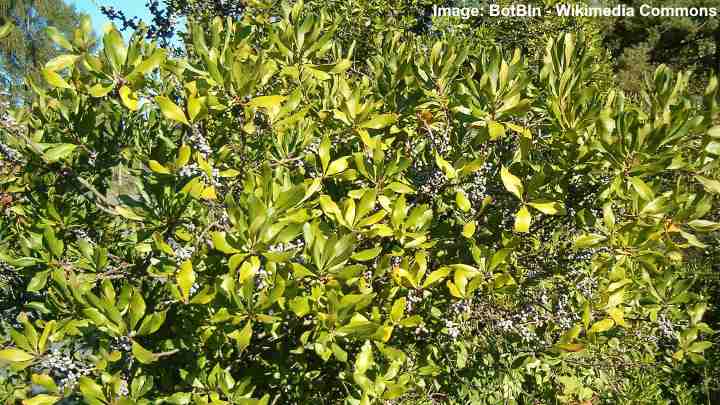
Wax myrtle is a versatile large evergreen shrub or small multi-stemmed tree known for its abundant waxy blue berries and aromatic leaves. Native to Florida, the attractive small ornamental tree is identified by its glossy olive-green fragrant foliage, small creamy-white flowers, and blue-gray berries appearing in the fall.
Wax myrtle is a popular landscaping plant in coastal areas of Florida. Also called the southern barberry, it performs well in full sun growing as a specimen plant, evergreen hedge, or privacy screen.
- USDA Growing Zone: 7 to 11
- Sun Exposure: Full sun or partial shade
- Mature Size: 10 to 15 ft. (3 – 4 m) tall and 8 to 10 ft. (2.4 – 3 m) wide
- Soil Needs: Slightly acidic soil
- Water Needs: Tolerates drought and flooding once established
Buttonwood (Conocarpus erectus)

Native to Florida, buttonwood is a small, low-branching evergreen tree with an attractive rounded crown and a twisted trunk. The identifying features of the tree are smooth, pinnate leaves 4” (10 cm) long, conical flower clusters, and showy, button-like purple fruits. Its sturdy wood is hurricane-resistant, ideal for Florida’s harsh climate and tropical storms. Its salt and drought tolerance make it ideal for Florida coastal areas.
- USDA Growing Zone: 9 to 11
- Sun Exposure: Full sun
- Mature Size: 20 to 40 ft. (6 – 12 m) tall and wide
- Soil Needs: Most soil types, from dry to clay, and withstands salty soil
- Water Needs: Drought-tolerant
Pawpaw (Asimina triloba)

Pawpaw is a small deciduous tree known for its spectacular, colorful foliage in the fall. The features of pawpaw trees are their delicious and unique fruit with a banana-like flavor, cup-shaped purple flowers, and large leaves 12” (30 cm) long. The fruit from the pawpaw tree is described as a combination of banana and mango with a custard-like texture.
Pawpaws perform well in damp areas or gardens with poor drainage. They are ideal for city gardens, rain gardens, or small shade trees near ponds or streams. Their growing range extends from North to Central Florida.
- USDA Growing Zone: 5 to 9
- Sun Exposure: Full sun or partial shade
- Mature Size: 15 to 30 ft. (4 – 9 m) tall and wide
- Soil Needs: Acidic or neutral soil types
- Water Needs: Medium to wet, well-drained soils
Seagrape (Coccoloba uvifera)

Seagrape is a native Florida plant that can either grow as an evergreen shrub or as a small tree. It is commonly found along sandy beaches and coastal dunes in South and Central Florida. Seagrape is identified by its large, leathery, round, evergreen leaves, long clusters of creamy-white flowers, and small grape-like fruits that ripen to red or purple. The native tree tolerates coastal conditions and is ideal for beachfront homes.
Seagrape can reach a height of 10 to 50 feet (3 to 15 meters) and develop a small tree-like appearance. In coastal landscapes, it is often pruned to maintain a smaller size and shape, making it a popular choice for ornamental use in seaside gardens and as a shade tree in beachfront areas.
While it is capable of growing into a small tree, Seagrape is more commonly managed as a shrub, and its ultimate size can be influenced by local growing conditions, including soil quality, exposure to salt spray, and available space. Proper pruning and maintenance can also help shape it into the desired form, whether as a shrub or small tree.
- USDA Growing Zone: 10 and 11
- Sun Exposure: Full sun
- Mature Size: 10 to 50 ft. (3 – 15 m) tall and up to 30 ft. (9 m) wide
- Soil Needs: Well-drained, sandy, or loamy soils
- Water Needs: Highly tolerant of dry soils
Other Native Florida Plants: Ground Covers, Vines, Ferns, Grass, and Yucca
Purple Passionflower (Passiflora incarnata)
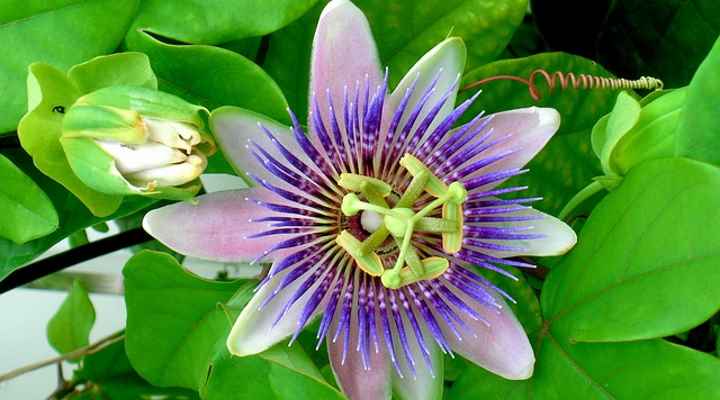
Passionflower is a beautiful, unique purple-flowering vine identified by its intricate and exotic flowers. The unique purple, pink, or white flowers have a central disk with showy stamens and are surrounded by colorful petals and long, delicate tendrils. The stunning tropical flowers measure 3” to 5” (7.5 – 13 cm) across.
Passionflower, also called maypop, is a vigorous grower and can grow up to 8 ft. (2.4 m) tall and wide. Its attractive flowers and tear-drop-shaped leaves look stunning climbing over trellises, fences, or arbors. The flowering twining vine is ideal as a climbing plant or ground cover for full sun.
- USDA Growing Zone: 6 to 11
- Sun Exposure: Full sun to partial shade
- Mature Size: 6 to 8 ft. (1.8 – 2.4 m) tall and up to 6 ft. (1.8 m) wide
- Soil Needs: Well-drained, average soil
- Water Needs: Moist to occasionally dry soil
Beach Morning Glory (Ipomoea pes-caprae)
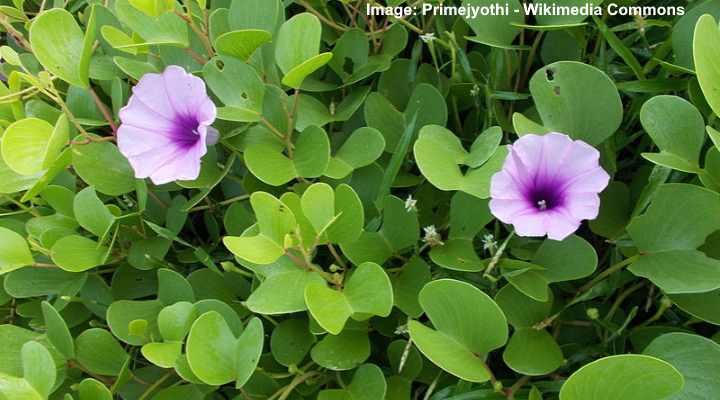
Also called railroad vine, beach morning glory is identified by its violet, pink, or lavender trumpet-shaped flowers, creeping stems, and evergreen foliage. This plant is native to coastal areas in Florida. Its tolerance for sandy and salty conditions makes it popular for beachside gardens and landscapes.
Beach morning glory’s sprawling growth is ideal for forming dense ground cover in dry landscapes.
- USDA Growing Zone: 8 to 11
- Sun Exposure: Full sun
- Mature Size: 4” to 6” (10 – 20 cm) tall and up to 60 ft. (18 m) wide
- Soil Needs: Well-drained sandy, loamy, or nutrient-poor soil
- Water Needs: Drought-tolerant once established
Fakahatchee Grass (Tripsacum dactyloides)

Fakahatchee grass is a native grass found in Florida and is known for its tall floral spikes of orange or purple flowers. The clumping ornamental grass features arching, narrow, flat blades that turn orange-pink in the fall. It grows up to 8 ft. (2.4 m) tall, and its flowering spikes are 10” (25 cm) long.
Fakahatchee grass is a warm-season grass that spreads by self-seeding. It thrives in full sun and tolerates hot, dry weather. Landscape uses for the grass include ground cover, a perennial border, or as an accent plant.
- USDA Growing Zone: 4 to 10
- Sun Exposure: Full sun or partial shade
- Mature Size: 4 to 8 ft. (1.2 to 2.4 m) tall
- Soil Needs: Well-drained, average soil
- Water Needs: Drought-tolerant but can also grow near ponds
Pink Muhly Grass (Muhlenbergia capillaris)

Pink muhly grass is a stunning ornamental grass that adds a pop of pink colors to Florida landscapes. This grass resembles cotton candy with feathery pink plumes and finely textured grass blades. The clumping grass grows up to 3 ft. (1 m) tall and thrives in drought-prone landscapes.
Pink muhly grass can be used in southern landscapes as a border or edging plant or as a focal point in a container garden. This grass is low-maintenance and drought-tolerant, making it an excellent choice for busy gardeners. Ideal for Florida landscapes, the grass is tolerant of salt, humidity, heat, nutrient-deficient, drought, and salty ground.
- USDA Growing Zone: 6 to 11
- Sun Exposure: Full sun
- Mature Size: 2 to 3 ft. (0.6 – 0.9 m) tall and wide
- Soil Needs: Sandy, rocky, or dry soils
- Water Needs: Low to moderate water requirements
Southern Shield Fern (Thelypteris normalis)

Southern shield fern is a native Florida fern species that thrives in the shade. The fern plant is characterized by its delicate, lacy, triangular fronds, bushy growth, and creeping habit. The vibrant green arching leaves grow up to 4 ft. (1.2 m) tall and wide.
Low-maintenance southern shield ferns thrive in various conditions, especially heavy shade. The tropical ferns are ideal for adding texture and greenery to shady areas like under large shrubs, trees, or along a foundation line.
- USDA Growing Zone: 7 to 10
- Sun Exposure: Partial shade to full shade
- Mature Size: 2 to 4 ft. (0.6 – 1.2 m) tall
- Soil Needs: Moist, well-draining soil
- Water Needs: Regular watering to keep the soil consistently moist
Adam’s Needle Yucca (Yucca filamentosa)
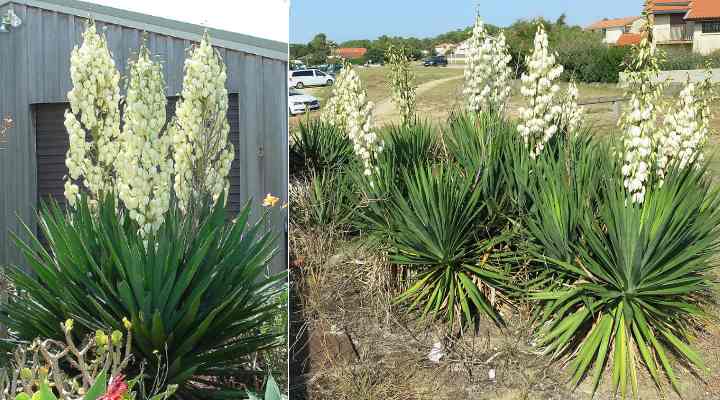
Adam’s needle yucca plant is known for its stiff, sword-like leaves with white thread-like filaments along the edges. The evergreen plant features a rosette of spine-tipped leaves, and it blooms in mid-summer with an eye-catching flowering stalk 5 to 8 ft. (1.5 – 2.4 m) tall. The tall flower stalks consist of clusters of creamy white bell-shaped flowers.
Adam’s needle yucca is low-maintenance and drought-tolerant, ideal for Florida’s climate. Landscape uses for the ornamental plant include a specimen plant, xeriscaping, border edging, or creating an architectural accent.
- USDA Growing Zone: 4 to 11
- Sun Exposure: Full sun
- Mature Size: 2 to 3 ft. (0.6 to 1 m) tall and wide
- Soil Needs: Light, sandy soils
- Water Needs: Drought tolerant and survives in dry soils
How to Choose Native Plants to Grow in Florida
Choosing the right native plants for your Florida garden can be challenging. Florida has humid tropical conditions and warm winters in the south. However, in the northern regions, temperatures can dip below freezing during the coldest months. Therefore choosing the correct USDA hardiness zone is crucial for front or backyard landscaping in Florida.
Other considerations when identifying the best native Florida plants include soil type, sunlight exposure, proximity to the sea, and the size of the plant. For example, small native plants are ideal for compact garden landscapes. However, salt and drought-tolerant plants may be necessary for hot, coastal regions where they deal with sea spray or dry conditions.
Related articles:
